Turquoise Energy News #205
Covering
Research & Development Activities of June 2025
(Posted July 13th 2025)
Lawnhill BC Canada - by Craig Carmichael
[Subscribe: email to
CraigXC at Post dot com ; request subscription]
Main URL TurquoiseEnergy.com
Also at craigcarmichael.substack.com
Month
In "Brief" (Project Summaries etc.)
* SeaWing (addendum) - OLAHP - 36V Popcorn Experiment - Off Grid:
Charging The Nissan Leaf from DC Solar/Battery Power - New
Grid-Tied Solar System - Cabin Construction - Plug-in Got Hot
In Passing
(Miscellaneous topics, editorial comments & opinionated rants)
* Aging Eyes: Lens Hardening & Cataracts
Reduction/Reversal with Bromeliads?
* Electrosmog
* ESD
- Detailed
Project Reports -
Electric Transport - Electric Hubcap Motor
Systems (No Reports)
Other "Green" &
Electric Equipment Projects
* Charging The Nissan Leaf from DC Solar/Battery Power
* Faraday Cabin: Wall Insulating, Board, Painting - More
Scaffolding - The "Electrosmog", Tinnitus, blah blah...
* Haida Gwaii Gardening
Electricity
Generation
* New 7 KW Grid Tied Solar System: 20 x 350W solar panels -
Installation [part 1] - Solar Panel Efficiencies
* The usual Latest Daily/Monthly Solar Production log et
cetera - Monthly/Annual Summaries, Estimates, Notes
June
in Brief
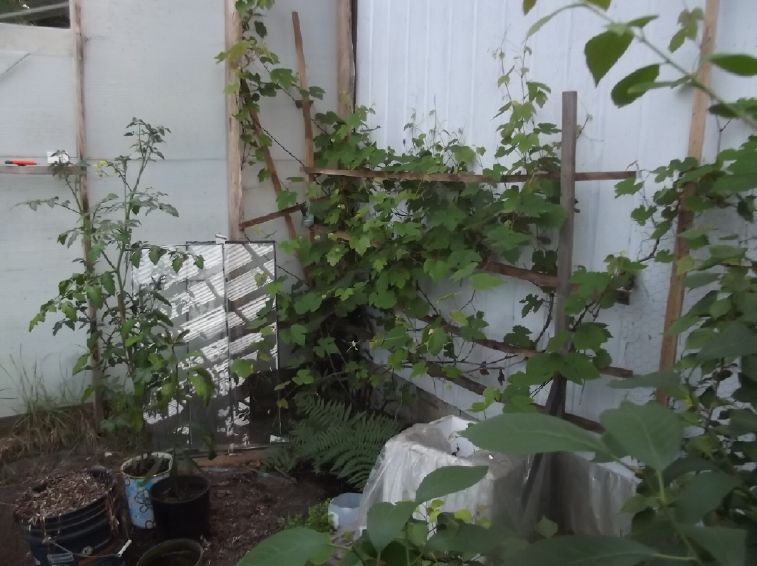 Grape vine - no grapes
Grape vine - no grapes
Well, here it is
mid July for the June report. I've written too much and made
probably too-long reports many times, and this is certainly one of
them, and yet the more inventive projects got little time or
attention in June. I did get some done on the cabin, and in the
latter part of the month the experiment of charging the Nissan
Leaf from the DC/solar system took a couple of days to get
working, plus the new grid-tied solar system going up and lots of
gardening seemed to take all my time.
For Haida Gwaii gardening,
there's lots of pictures and remarks in the 'detailed report'.
Some people are definitely better than me at starting and growing
seedlings in the spring, but I think it's worth writing about
because the climate challenges are rather unique to Haida Gwaii as
well as to the BC coast in general. This spring and early summer
the weather has been mostly cold and damp - lousy, and most things
haven't been growing well.
SeaWing - Rapid Transport over Water - addendum
Before getting into June, here's a thought left over
from the Sea Wing design idea of May: the rear "transom" that is
part of lifting the boat out of the water to ride like a
hovercraft at high speeds I think should be retractable so it can
be raised out of the water at lower speeds. Otherwise it will
create much turbulence and prevent the craft from running nicely
as a catamaran. Intermediate positions might even help the boat
pick up speed and climb out of the water.
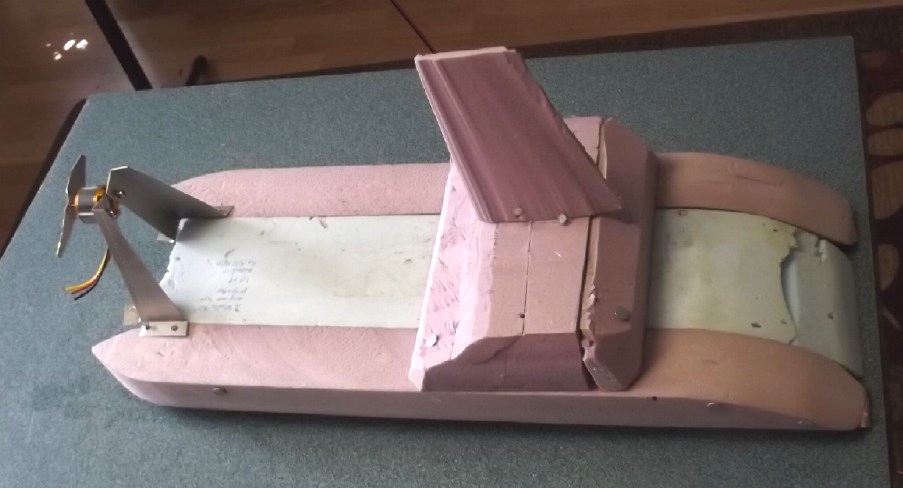
With rear 'hovercraft'
'transom' fully deployed
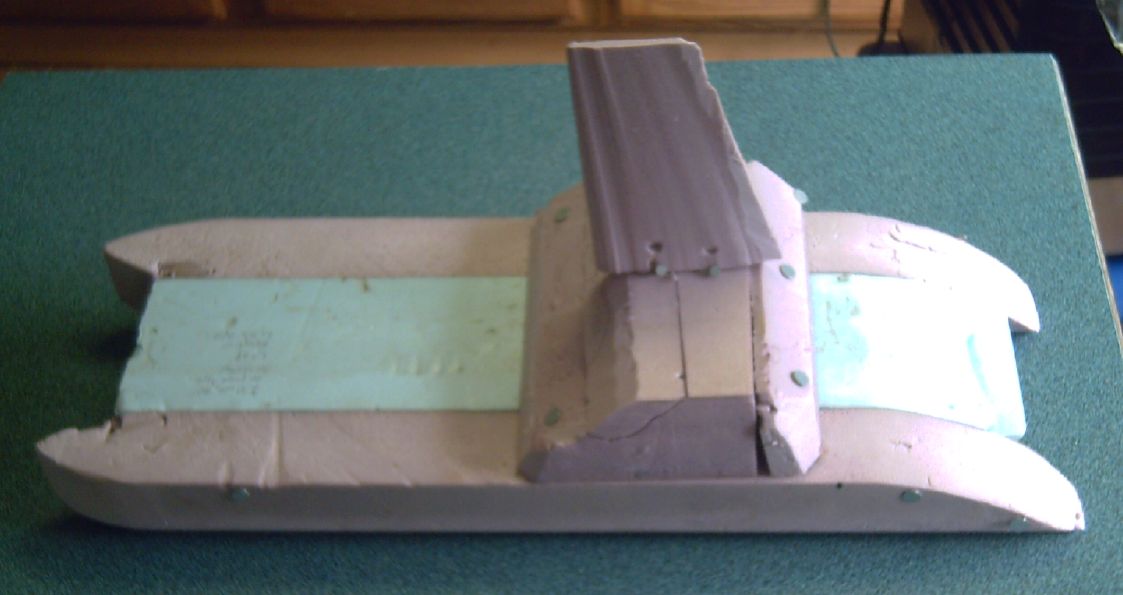
Showing Rear 'skirt' sort of retracted
36V Popcorn Experiment
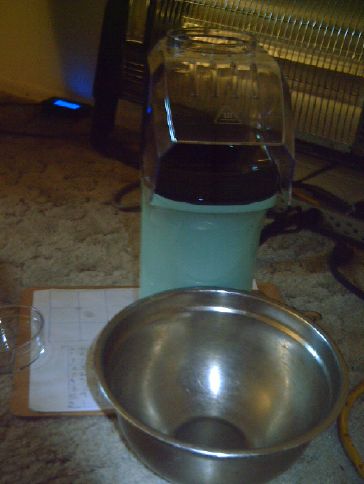
One day it occurred to me that air popcorn makers had
a brush type motor and a simple resistance heating element. Both
would run on AC or DC. What would happen if I plugged one into 36
volts DC? It ran fine. It ran for 20 minutes, but no popcorn
popped. It just didn't get hot enough. Oh well. The "preheated"
popcorn popped pretty fast when I gave up and plugged it into
120V.
I suppose if I really, really wanted a 36 volt
popcorn maker, I could take it apart and unwind some of the heater
windings so it got hotter at the lower voltage. I think the motor
ran fast enough. I think.
Better, I could take one of the two or three "dead"
ones on my shelves that need repair and change it. (They
eventually flake out after roasting too many batches of coffee.)
OLAHP
[12th] I took the motor apart. Aside from dust bunnies, there were
four spade lug terminals with wires. I swapped two wires and the
motor ran the right direction, clockwise. Yay! (That's the
progress for a MONTH?!?)
Off-Grid EV Charging: Nissan Leaf
I had always assumed I could simply plug the Leaf's
120 V AC charging unit into an inverter to charge the car. But
when I actually tried it, it turned out to be less simple than
that. Some work went into getting it working.
It's a natural to charge my two experimental vehicles
from the 36 volt DC solar/battery systems - the cars' batteries
themselves are 36 volts (two sets for 72V in the Miles mini cargo
truck) so they will charge directly, from whatever sun is
available. The Nissan Leaf is a different prospect. Its battery is
ten times the voltage (nothing to fool around with!) and the
provided charger is 120 volts AC only, supplying exactly 1500
watts to the car. If a full 1500 watts isn't available, it doesn't
just charge slower, it doesn't work at all.
1500 watts is only available direct from the nine
solar panels in the middle of a sunny day in the summer, of which
we have had about two in the last four summer weeks this year so
far. (Yuck!) More common in overcast is 400-800 watts, even under
100 in winter.
So to charge the car, the house (or cabin) battery
must be charged first, then the energy from that battery plus
whatever is coming from the sun can be used to charge the car with
an inverter to 120 V AC. But the house battery is only 10 KWH,
while the Leaf's is 24 KWH. So if the car is below maybe 65%,
which it usually is since nearly all my drives are long highway
drives, one can't just plug in the car and forget it. It might
kill the house battery. Presently for the experiments I set the
alarm timer on the kitchen stove to 3 or 4 hours, and usually I
hear the cooling fans as I walk by the garage, so I check it. But
I am prone to going off and forgetting things entirely. What is
really needed is a low voltage cutout that will then stay off
until manually reset, or at least a timer that will switch off
1500 watts.
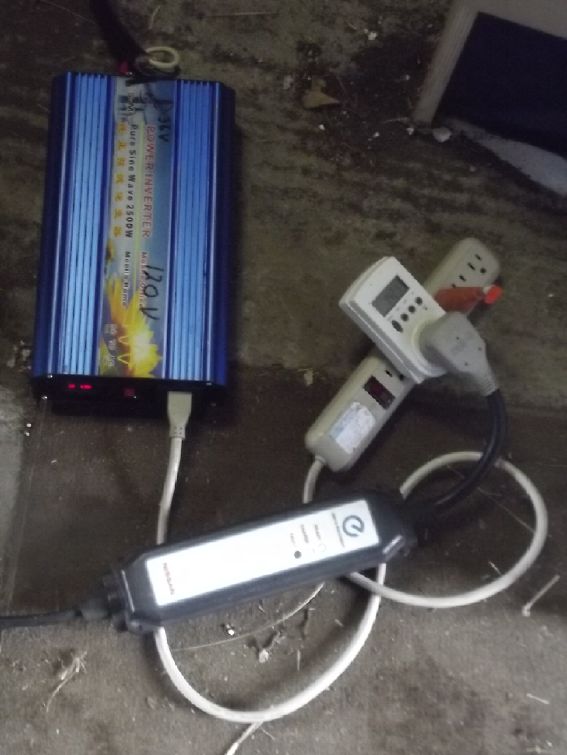 The first hurdle to
making it work was that when plugged into the inverter the Leaf's
charging unit just sat there with its green light blinking. Turns
out it thinks it's plugged into a 2-prong cord and decides that's
not good enough. But inverters have no ground on the ground pin.
Where would they get a ground from? One must use a plug to short
neutral to ground, to trick it. In order to connect that, one must
plug a power bar or splitter into the inverter, to plug in both
the Leaf's charger and the ground-to-neutral shorting plug. (Foto:
I also put an AC power monitor in line with the charger.)
The first hurdle to
making it work was that when plugged into the inverter the Leaf's
charging unit just sat there with its green light blinking. Turns
out it thinks it's plugged into a 2-prong cord and decides that's
not good enough. But inverters have no ground on the ground pin.
Where would they get a ground from? One must use a plug to short
neutral to ground, to trick it. In order to connect that, one must
plug a power bar or splitter into the inverter, to plug in both
the Leaf's charger and the ground-to-neutral shorting plug. (Foto:
I also put an AC power monitor in line with the charger.)
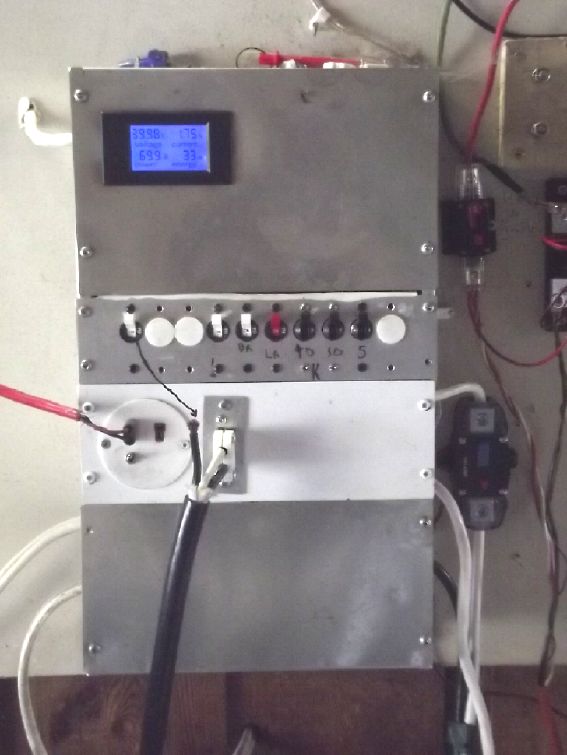 Then my long house-wire
to the 36V, 50A outlet in the kitchen wasn't actually heavy enough
for 50 amps. The inverter would cut out almost as soon as the
charge started because the voltage dropped too much.
Then my long house-wire
to the 36V, 50A outlet in the kitchen wasn't actually heavy enough
for 50 amps. The inverter would cut out almost as soon as the
charge started because the voltage dropped too much.
With much fuss and 3D printing effort I ended up
making another 50A outlet in the garage at the 36V main box. I
also had to change a couple of breakers there because the charger
drew 41 amps and soon blew the 40 amp one.
(Putting in a new 100 amp surface mount "main"
breaker (lower right) allowed me to use the previously "main" 50
amp breaker in the box for the new outlet. Arrow in felt pen.)
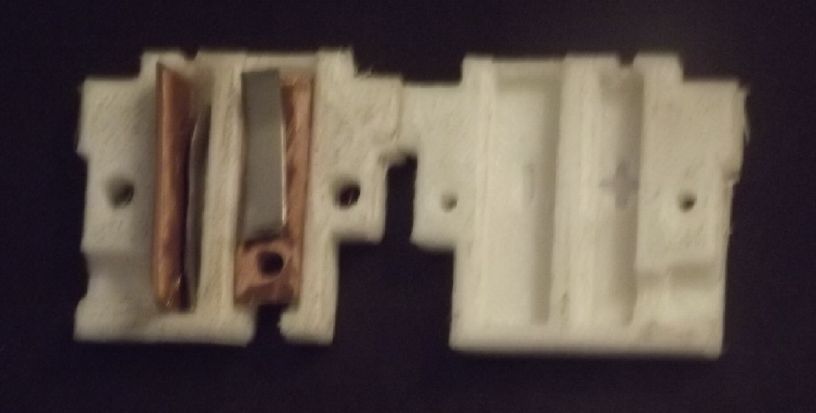 At last the nylon shell
printed nicely, but Getting the blades and
At last the nylon shell
printed nicely, but Getting the blades and
springs just right so the plug fits nicely is still a bit of an
art.
[More details under "Other Projects"]
After all that it worked quite well. I've ordered
another 2500W inverter and 3D printed another 50A receptacle and
wall plate for the cabin system. If I really want to charge the car
off-grid and there's not enough sun, I could charge it half way at
the house, then drive it down to the cabin and charge the rest of
the way.
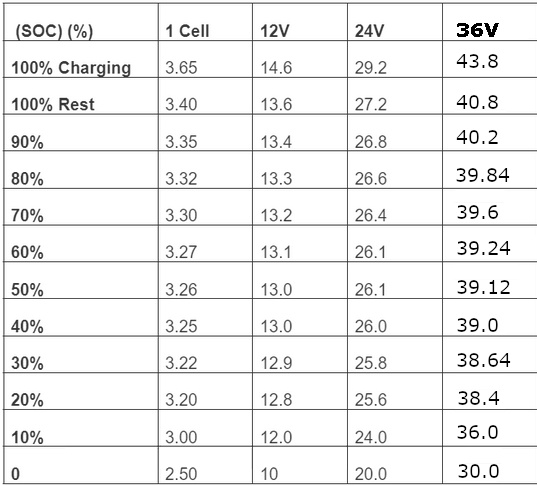 Table: Lithium-Iron
Phosphate Battery Charge Versus No-Load Voltage.
Table: Lithium-Iron
Phosphate Battery Charge Versus No-Load Voltage.
To estimate charge one must first turn off the load (car
charging)
as well as the solar input, then wait for the no-load reading to
settle.
I charge at only 40.8 volts.
It's not as fast charging to 100% as going higher would be, but
with charging lasting all day every day from solar energy it's
surely better for the battery cells, especially in colder
weather.
Soon it will be easier and faster to charge from the
power grid, and get a credit from BC Hydro for power generated by
the new solar system.
New Grid-Tied Solar System
In November BC Hydro finally told me to get my
hodge-podge grid tied systems inspected and approved or taken off
line. I didn't think the simple plug-in grid ties (and various
details of my work) would be considered acceptable, so I
disconnected them. But I turned both the house and the cabin into
two off-grid battery systems each with a 10 KWH, 36V battery - and
nine solar panels each, still in a hodge-podge of places.
In January I ordered an approve-able 7 KW solar
energy system kit with twenty 350 watt solar panels and ten
dual-panel grid tie inverters. It arrived and occupied a garage.
Finally in mid June, anticipating good summer weather, I
advertised for a helper to help me mount them on the roof of the
house. Immediately a former telephone company outside worker who
lived just down the road responded. Perfect - someone nearby and
familiar with this sort of job! The good weather didn't come. We
had to cancel many days, and we quit early owing to rain a couple
of times (the sloping metal roof quickly becomes slippery and
dangerous), but we finished on July third.
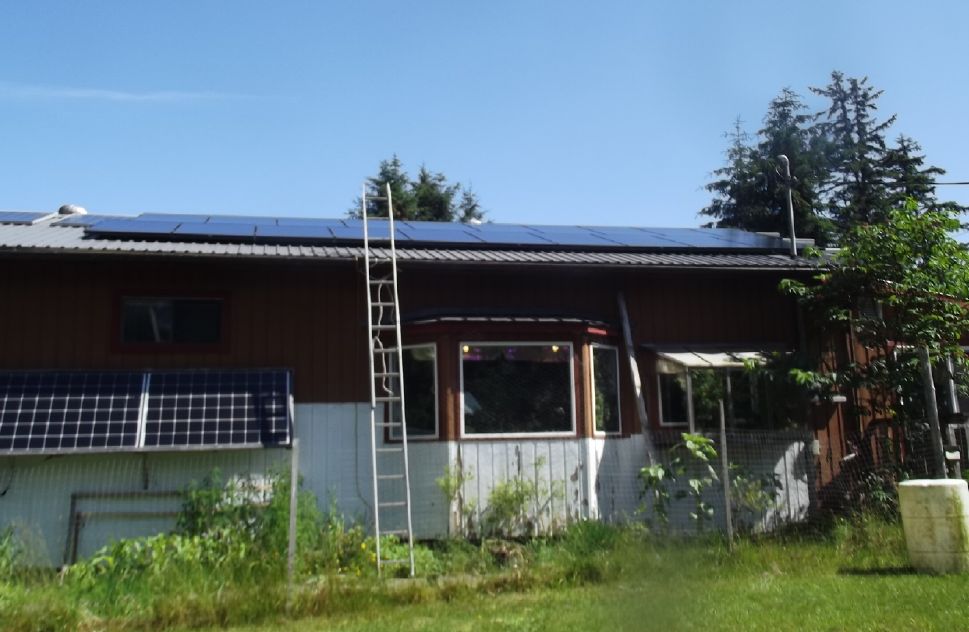 The scattered old panels
pale beside the new array of extra large ones
The scattered old panels
pale beside the new array of extra large ones
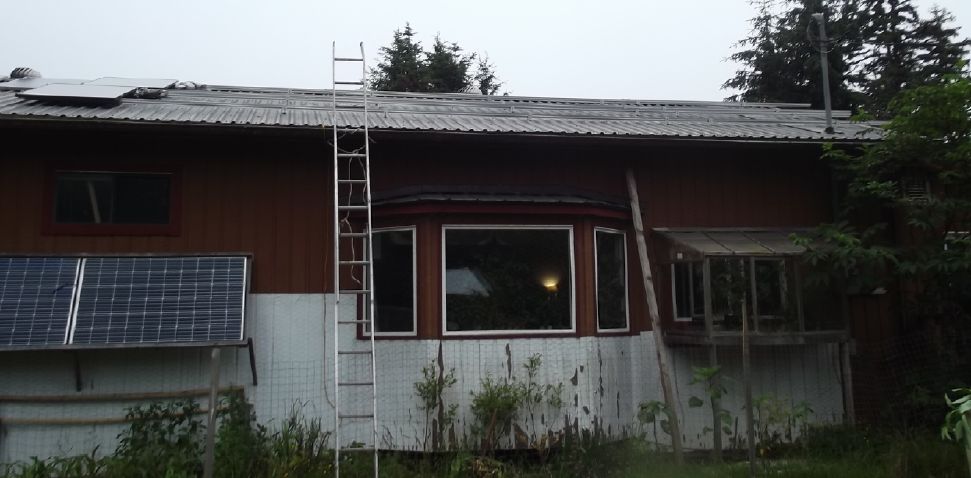
Progress by 23rd: Rails up plus a couple of panels and grid-tie
inverters
Now I'm waiting for the electrician, who also must do
the legalize for the project to put it on the grid as well as look
after his sister's kids while she has a baby.
It turned out the BC Hydro spokesperson at the
Renewable Energy Conference last September had apparently
misinformed me. The "up to 75% rebate" for costs is only available
for community projects under the auspices of native bands, not to
individual homeowners even on a diesel-run "microgrid". He told me
it was, but the application makes no mention of it, and now
reading the actual literature from Hydro, it doesn't either. I
think he must have misunderstood it himself. All I can get is
5000$, which barely covers the 4500$ shipping of the solar kit
from Ontario, never mind the 11,000$ for the kit or labour costs.
Estimating 2000$ for the electrical work, I'll be out around
13,000$ instead of just a few thousand. I'm not sure I'd have
taken on this project had I known the actual terms.
I get credit for electricity produced which will
reduce my annual electric bill, but it'll take quite a few years
to recover the money I've put out. Oh well, much of my money comes
from the government in the form of OAP anyway, and over time it
will save a quite lot of non-renewable diesel fuel!
Faraday Cabin Construction
I insulated the gable end wall with scraps of styrene
foam and then covered it with scraps of the thin plywood. It
looked pretty ugly until I painted it white. In spite of other
seeming "priorities" I painted the upper wall while the
scaffolding is there because I'd be way up on a ladder to do it
later.
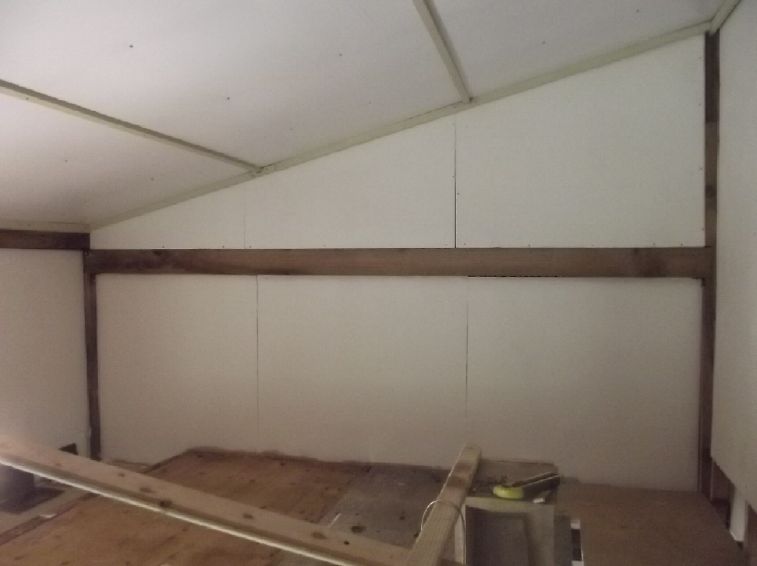
Later I used drywall filler in the cracks between sheets of
plywood wallboard. Why not? It looks better without the cracks.
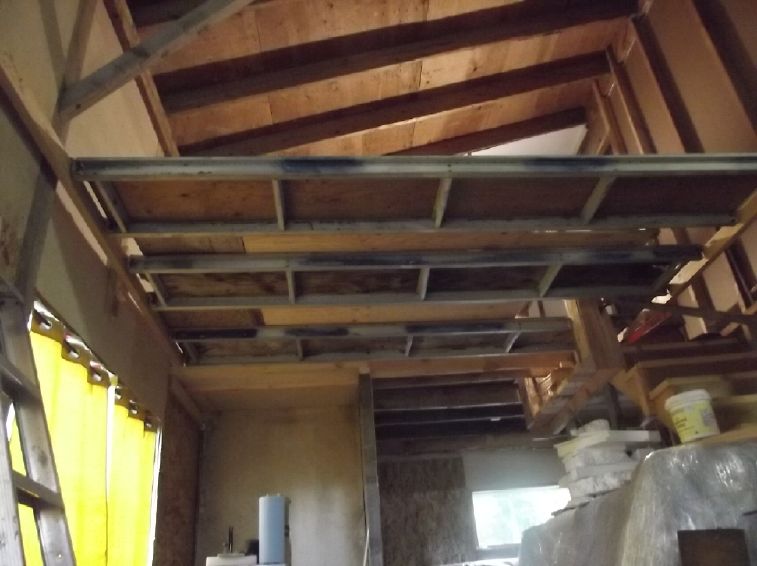 Near the end of the month I figured
out how to put up scaffolding to do the next section of ceiling,
using actual steel frame scaffolding "planks" but with 2 by 4's
screwed into place to hook the ends onto. I spread them apart to
expand the "floor" area, and put chunks of plywood across to stand
on.
Near the end of the month I figured
out how to put up scaffolding to do the next section of ceiling,
using actual steel frame scaffolding "planks" but with 2 by 4's
screwed into place to hook the ends onto. I spread them apart to
expand the "floor" area, and put chunks of plywood across to stand
on.
Got Hot
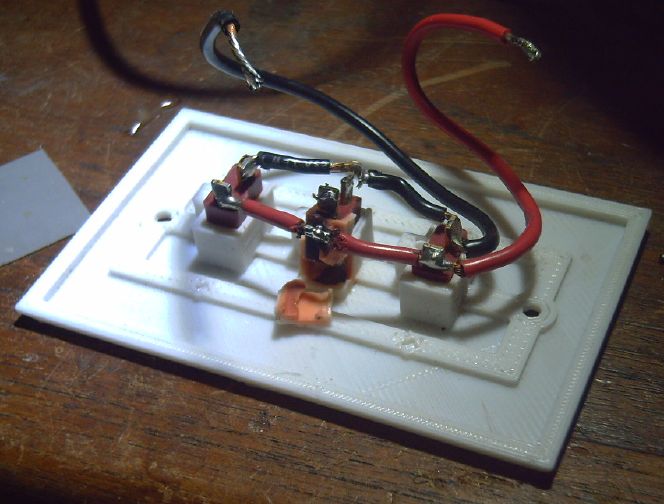 That 36 volts won't electrocute
doesn't mean it can't arc and get hot with high loads and poor
connections. The middle socket on this plate in my bedroom had a
badly connecting electric heater which finally did in the plate
plastic. The socket itself is high temperature nylon - and this is
why.
That 36 volts won't electrocute
doesn't mean it can't arc and get hot with high loads and poor
connections. The middle socket on this plate in my bedroom had a
badly connecting electric heater which finally did in the plate
plastic. The socket itself is high temperature nylon - and this is
why.
In
Passing
(Miscellaneous topics, editorial comments & opinionated rants)
Aging
Eyes:
Lens
Hardening
& Cataracts Reduction/Reversal with Bromeliads?
A few years ago I saw something online about people
reducing eye floaters by eating fresh pineapple. A whole group
study was done on it and many in the group claimed good results.
Fresh pineapples aren't very available around here.
It turns out that the bromeliad family of plants
(including pineapple) was about the last one to evolve, in South
America. It also turns out that an ingredient in the sap,
bromelene, has a unique property of being able to dissolve
proteins.
I have some considerable eye floaters that really
show up against a brighter cloudy sky or a white computer monitor.
For a while I tried eating bromelene pills, but it didn't seem to
do anything. But I didn't see why it would. After all, how is the
bromelene going to survive going through the digestive system and
somehow get to the eyes, intact? A more direct approach seemed to
be required. I started thinking the fresh pineapples worked by
squirting mist with bromelene into the air and it getting into
people's eyes rather than through the eating.
One day I went by the plant store, "Funk It". On an
outside table ("This table free") was a plant. I recognized that
it was a bromeliad. It was labelled "Fasciata", one whose flower
had come and gone. I took it. (The best things in life are free?)
Now what?
I came up with a wild plan: cut a small piece of
leaf, rip it up and crush it in a little capfull of water.
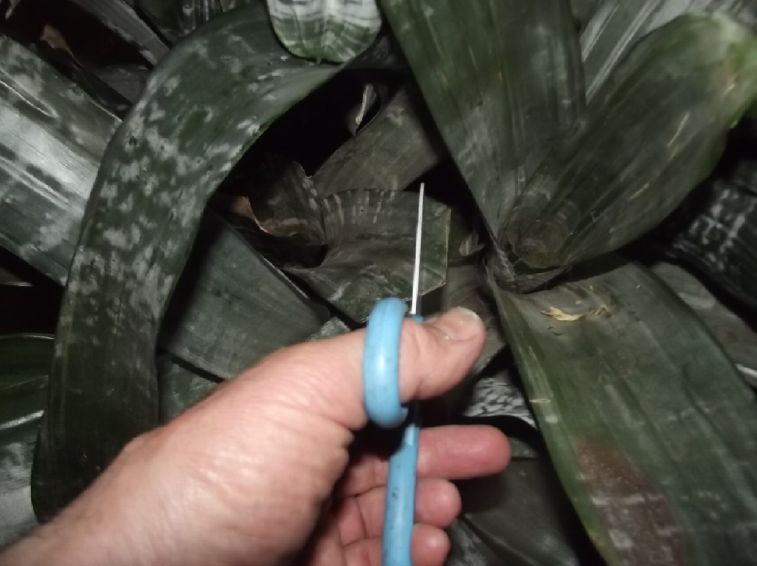
Cutting a piece of leaf
from the wildly overgrown fasciata
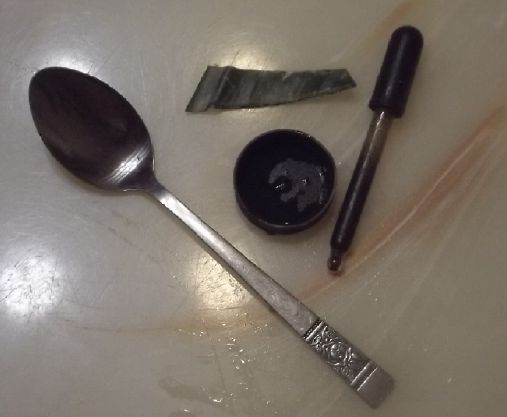
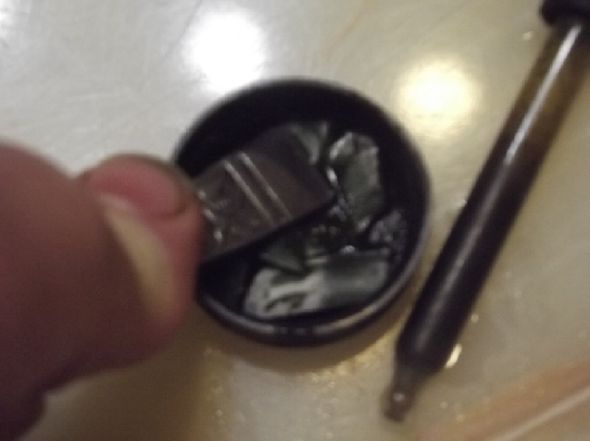
Munch up the leaf in a bit of water.
(Ya, no doubt I could find something better. A tiny mortar
& pestle?)
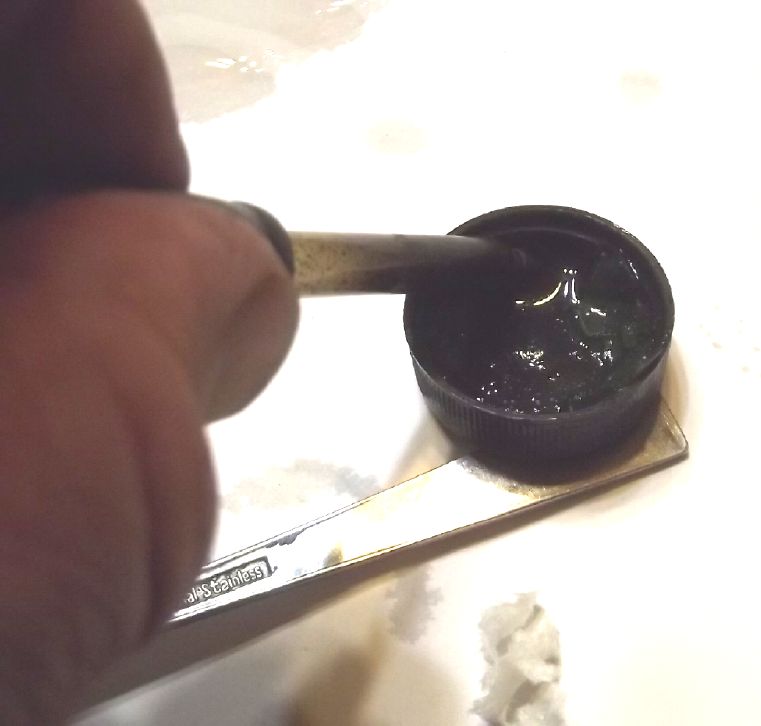
Suck up the 'juice' and put a drop or two in each eye.
I find touching my eyelash with the tip of
the dropper is a good way to help position it.
Drop a drop or two in each eye with an eyedropper. I tried that
occasionally, to little apparent effect. I'd like to have saved
the water, but it seems to me that it won't work unless it's truly
fresh, so I cut another bit of leaf and mixed a new batch each
time.
I started making it stronger, just a few drops of
water in the cap, turning green with the crushed plant juice. I
would blink and roll my eyes around, then blot off the remaining
excess. I started doing this often, every two or three or four
days. It seemed to me the floaters got a little lighter, but it
wasn't a very satisfactory or fast cure.
In the last couple of months I've started doing it
daily, and that seems to be more effective -- but not on the
floaters. For many years now I have only been able to read books
with my left eye. My right eye has long had good distance vision,
but not much close focus. In the last couple of weeks I've started
to be able to read printed pages with my right eye again, even
with my left eye covered. It's still blurry, I squint a little,
but I can make out typical book size printing (without reading
glasses), which has eluded my right eye for some years. (People
say "Don't squint", but if it helps to focus what otherwise isn't,
what's wrong with it?)
I started out trying to reduce or cure floaters,
which would seem to be composed of dead matter in the eyeball, but
it seems to me the fresh bromelene is, even more, dissolving dead
matter in the lens - "trash" that builds up and hardens it over
the years and causes cataracts as we get older. The lens and
cornea is at the front of the eye where the drops reach best. The
floaters are deeper, somewhere in the eyeball.
I should mention it's been several years now and I've
certainly done my eyes no apparent harm. (Some people have
apparently harmed their vision with castor oil drops. Don't try
castor oil!)
It's "garbage collection." I don't imagine I'll ever need reading
glasses except for very fine work and tiny print, nor ever need
cataract surgery.
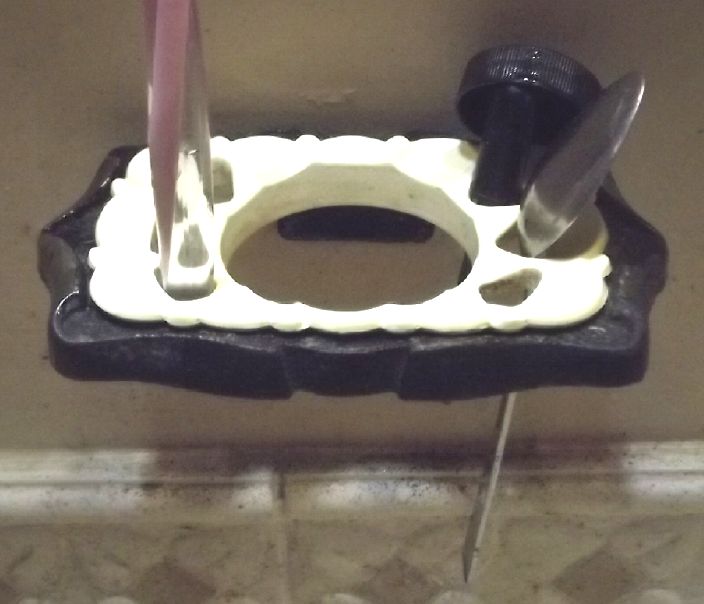
Put away stuff in toothbrush holder for next time
This is just the most recent of things I've tried to
keep my vision healthy, now as I enter my 70's. I try not to focus
too close too much for too long and become nearsighted. (This is
evidently happening a lot to young people peering at the tiny
screens on cellphones. It used to be from reading too many books,
but even that's not as bad as cellphone screens!)
In my early 50's I started to have trouble reading
books (even with my left eye) and I started doing the Edgar Cayce
head and neck exercise as I walked, 3 or 4 times, as recommended
to retain close vision when older. This excercise, which has no
direct effect on the eyes, is said to stimulate the thyroid, and
somehow that helps the vision. It definitely seems efficacious and
I still do it. People seem surprised that I don't use reading
glasses.
I also drink carrot juice, made fresh with a juicer.
I used to drink a lot of it. It really does help keep the visual
acuity sharp. I sprinkle a bit of agar into the juice (and stir)
as gelatin is said to help the body absorb the nutrients from
vegetables. More recently I've been juicing just a bit of
lemongrass with the carrots, which is reputed to have some great
nutrients in it. But I get lazy because of the effort in making
juice and cleaning out the juicer afterward. One can also of
course eat carrots. The beta carotene is the vital ingredient.
As people live longer, more "tricks" to retain or
regain overall good health into older ages seem to be required.
Electrosmog
* Kevin, always looking into human
caused environmental problems, gave me a two-page copy of an
article by Dr. Magda Havas [MagdaHavas.com] about Electrosmog
and ElectroHypersenitivity (or just Electrosensitivity).
Seeing
how
pervasive
oscillating electric fields have become most everywhere in the
human environment, from 50 or 60 hertz VLF up to UHF and 5
gigahertz SHF from a myriad of sources, the term "electrosmog"
seems fitting. We don't sense it directly, but it is all around
us.
Exposure guidelines or regulations (applying only to
certain frequencies to begin with) were designed to protect early
radar operators from short duration UHF ("microwave") exposure.
They were never intended for continual and repeated 24 hour a day
WiFi signals from routers, cell phones, computers or baby
monitors, or AC power fields.
Havas, who has now been studying the subject for 25
years, says that ~25% of people are adversely affected and 3% to
the point of being unable to function properly 'in the modern
world'. Tinnitus was only the last of a long list of adverse
effects: ("headaches, chronic pain, chronic fatigue, sleeping
problems, difficulty concentrating, poor short term memory, mood
disorders including depression and anxiety, dizziness, nausea, and
tinnitus.") She says it causes "premature aging". (Hey, she didn't
even mention "cancer" from UHF - cell phones, etc!)
And of course all this is poorly understood. She says
psychiatrists say they are frequently being referred patients who
actually have physiological problems, not psychiatric ones.
Those producing offending products turn a blind eye
to it all and maybe even deny deleterious effects, just like
cigarette makers, industries causing acid rain and others did or
still do, until the effects and evidence are overwhelming and
governments take regulatory action. I'll keep working on my
grounded Faraday Cabin with the AC power and the WiFi on the
outside, hoping to be able to spend much of my time in it. I'll
put my computers in grounded wire cages with long cables to the
display, mouse and keyboard, and reiterate my growing conviction
that electric fields -- "Electrosmog" -- will be the great health
and wellness issue of this century.
Scattered
Thots
I once heard that the new year used to start in
March. Sounded odd but there's evidence that it's true: sept, oct,
nov and dec (SP? )are Latin for 7, 8, 9 and 10. If the year
started in March then September, October, November and December
would match insted of being two off.
ESD
(Eccentric Silliness Department)
* I have sometimes heard that people or things are in Limbo. I
finally looked it up on Google maps. Barbershop Limbo and Cafe
Limbo, both in Teheran. Some people in Tehran may be in Limbo, out
to lunch or both.
* I guess Limbo isn't as remote as Timbuktu, and is surely closer
than "here to YinYang".
* Many know that the "sandwich" was invented by the fourth Earl of
Sandwich so he could eat without interrupting his pool(?) game. I
finally looked that up, too, and found it's just a small town (I
had thought it was a shire/county). Where did its name come from?
If it was named in typical English fashion, for example "Oxford"
(that prestigious name!) is a shallow bend where cattle forded a
small river. I checked the satellite images and a bunch of photos
to see if there was some notable sandy feature or area in or
around the town, but I didn't find anything. I still suspect the
name "sandwich" was derived from sand somewhere.
"in depth
reports" for each project are below. I hope they may be useful to
anyone who wants to get into a similar project, to glean ideas for
how something might be done, as well as things that might have
been tried, or just thought of and not tried... and even of how
not to do something - why it didn't work or proved impractical.
Sometimes they set out inventive thoughts almost as they occur -
and are the actual organization and elaboration in writing of
those thoughts. They are thus partly a diary and are not
extensively proof-read for literary perfection, consistency,
completeness and elimination of duplications before publication. I
hope they may add to the body of wisdom for other researchers and
developers to help them find more productive paths and avoid
potential pitfalls and dead ends.
Other "Green" & Electric Equipment Projects
Charging The Nissan Leaf from DC Solar/Battery Power
(...does
this go under transport, other projects or electricity
generation?)
[19th] I had long been assuming that
if I ever wanted to charge the Nissan Leaf from the 36 V DC
solar/battery system in the house - or the one in the cabin -
there would be no problem doing so except that the Leaf battery
was bigger than the house or cabin battery. That still shouldn't
preclude the charging system working as long as the batteries
lasted, or on a sunny day with plenty of solar power.
But untried things are, well, untried. I plugged the
inverter into the "50 amp T-Plug" socket in the kitchen, plugged
an extension cord into the inverter, the 120 V AC Leaf charger
into the extension cord, and its charge connector end into the
leaf.
The Leaf charger's green "Ready" light just sat there
blinking.
[20th-21st] I consulted by phone with Tom in Victoria, who had
actually charged a Leaf from an inverter. He said something about
having plugged a power bar into the inverter and then the Leaf
charger into the power bar. Huh? What would that do? A noise
filter in the power bar? I tried a couple of power bars, then I
plugged in a short "ground fault breaker" safety cord. The
inverter wrecked it. Dang!
The next day Tom remembered he had plugged a "ground
to neutral line shorting plug" into the power bar, and sent a
picture. A vital detail! It makes sense that the AC ground pin
from the inverter is unconnected. The only place an inverter could
get a ground would be from the DC minus wire, but it would be
safer if the AC was floating with no direct connection to the DC.
With no ground connection, the Leaf charger assumes it's plugged
into a crappy 2-prong cord and won't operate.
[22nd] I took an old plug with short wires sticking out and
connected the ground and neutral together. I chopped the black
wire short and taped around the cord. I plugged it into a power
bar, the bar into the inverter, and the extension cord also into
the bar. The green light on the Leaf charger stayed on steady. It
didn't work but this time I suspected that the 1500 watt charger
dragged the voltage on the kitchen branch line too low and the
inverter choked. It's a very long run of #11 house wire ( 2 x #14
with 4 wires). Even with 1000 watts for the coffee maker it can be
down to 33 volts or so.
 So I took the DC power
cord off the inverter and put on an Anderson APP connector cable,
and took it out to the garage where the DC system box had that
connector.
So I took the DC power
cord off the inverter and put on an Anderson APP connector cable,
and took it out to the garage where the DC system box had that
connector.
With the very short run, the car started charging, at
~1500 watts. But the inverter was drawing 41 amps from the 36V DC,
and in a minute or so the 40 amp breaker blew. I tried again with
the same result. Oh great - I now see the "Blue Sea Systems"
breakers as oddballs. I don't want to buy more and I don't have a
bigger one. So to charge the car from the house system, I probably
need to change the whole breaker box. (as well as putting in a
"mega T-plug" receptacle in the garage so I don't have to keep
changing the inverter's power cable.)
To charge the car from the Cabin DC system I need to
put in a 50 amp receptacle. I do plan to do that, but I have yet
to make the receptacles.
Then I came up with another plan for the House
system: the main breaker was 50 amps. That is actually pretty
lightweight for the main anyway. If I added an external 100 amp
surface mount breaker, I could use the 50 for the new outlet. I 3D
printed a faceplate for a 50 amp receptacle. I dug out a 100 amp
breaker but didn't get any wiring done.
[24th] I wired up one of my earlier 3D print "draft" nylon
sockets. The printer didn't get the nylon hot enough and the
strands easily split, making the nylon prints anything but solid.
I tried to fuse the nylon strands together better with a heat gun,
but it was still pretty rough. I wrapped it in electrical tape to
hold it together. I made an alume faceplate to hold it in the
breaker/wiring box in the garage, instead of using the plastic
one. I screwed on the 100 amp breaker on the board next to the box
and rewired it.
I plugged in the inverter. The socket held together
but I have little confidence in it for long term repeated use. I
connected the power bar with the ground-neutral shorting plug.
Then I drove into town and back (picking up some more
styrene foam for cabin ceiling insulation), and got home with 55%
charge left. Now, time to charge back up! I plugged the Leaf 120 V
charging unit into the power bar and into the car. I turned the
inverter and then the power bar On.
It worked! I charged the car for the better part of
two hours, delivering ~2.7 kilowatt-hours to the car. The car's
charge indicator went from 55% to 71%.
The Leaf charger draws 1500 watts rain or shine. It
was cloudy. The solar charger was replenishing the house battery
at just 850 watts, which dropped off as clouds thickened and tree
shadows started crossing the solar panels. So maybe 2/3 of the 2.7
KWH came from the house battery, only 1/3 from the sun direct.
Sort of robbing Peter to pay Paul, but the house battery will
recharge from solar where the car just sits there. (rather slowly
unless the sun returns.)
So if push comes to shove, if there's an apocalypse
with no grid power, I *can* recharge the Leaf from solar, but when
I finally tested it I discovered there were a few things that had
to be done before it would work. That's why one tests things
instead of blithely assuming! And I have to watch it like a hawk
to make sure I don't over-discharge the house battery. When I
arrived the car said "8 hours to charge" (for charging on 120V.)
Assuming it went full blast for 8 hours, that would be 12 KWH from
the 10 KWH house battery. The sun might make up some, but it would
be a gamble.
In such a case I probably wouldn't be driving it more
than a couple of times a week - in the summer. Winter it would be
almost problematic. Still, even now I might occasionally charge it
on solar for the free electricity on sunny days if I'm back home
early enough that it will be charged - usually 6 or 7 hours after
driving to town and back (~55Km) - before the sun goes behind the
trees. OTOH once the new 7 KW grid tied solar system is in, it'll
be much simpler for it to just generate all it can and I get
credit for that from BC Hydro to charge the car with.
I continued the trials as much to test reliability and gain
confidence as to save a couple of dollars of grid power.
[25th] I drove to town again, and again plugged the car into the
solar via the inverter. It might be instructive to see where the
losses were with the high currents.
1. That the voltage drop from the solar charge controller to the
battery wasn't very high is indicative of the fact that the clouds
were heavy and the voltage at the charge controller was down. Only
200 watts was coming in. If it had been 1600 watts (40 amps) or
more in sunshine, the drop could easily have been a couple of
volts or more over the four foot #11 AWG wires.
And since the battery voltage is so critical to state
of charge, that would mean the battery would be allowed to drop by
two volts below full charge voltage. It might be said that the
battery under 1600W/40A load might gradually drop to less than 50%
of full charge even with full sunshine available. I think I should
rewire the charging section with at least #8 wires - preferably
#6! [Well, I had just the #6 cable for it and I rewired it a day
or two later.]
2. The drop from the battery (39.0V) to the distribution box
(38.3V) was about 0.7 volts with the 4 foot #6 cable. That's not
too bad.
3. The drop through the 6 foot #8 wires power cord to the inverter
(37.3V), drawing 1570W/41A was about 1.0 volts. 1.0V * 41A = 41W
loss. 41/1570=2.6% loss. The cable was warm along its whole
length. I'm happy to report that the plug & new socket seemed
to be no warmer than the rest of the cable. [Later: Actually I
think the junction was causing much of the heat, which radiated
down the cable from the plug.]
Still it does suggest that the inverter's power cord
should be #6 wires, especially as it is a 2500W (~66 amps) capable
inverter.
4. The distribution box meter said 1560W, but the AC meter the
Leaf charger was plugged into said only 1415W. That indicates a 9%
loss in the inverter. This doesn't seem unreasonable. Its cooling
fan was running continuously. But then again they were two
different meters so that figure could be considerably out. (I
checked that there were no DC lights or DC anything on, which
would have added to the 1560 but not to the 1415.)
I left it charging the car for the better part of 3
hours until the DC power box's monitor said 4.000 KWH. At that
point the car had gone from 61% to 78% charged. The voltage at the
box said 37.7V and I got a bit nervous about overdischarging the
house battery. But when I turned the load off the voltage soon
rose to 39.23V, which said there was still lots left.
 LiFePO4 Charge versus
Voltage
LiFePO4 Charge versus
Voltage
(Open circuit voltages: no load, not charging).
[27th] I tried charging the car from solar again. The house
batteries still seemed low, having now also run an electric heater
for a while and with dark cloudy skies. 1/3 or less of the 1500
watts was coming from the cloudy sky so even mid-day the batteries
were doing the bulk of the work. It really needed 27 solar panels
instead of 9 - or else sunshine!
The clouds got thicker and the voltage lower. I shut
it off after just 1.65 KWH, during which time the car reading went
from 33% to 42% charged. No doubt it could have gone a couple more
KWH, but I have a propensity to wander off and forget things, and
there's nothing to stop it from overdischarging the house battery.
To do this safely what I probably need is a low
voltage cutout (50 amps capable!), and it should be one that once
tripped just stays off until manually reset. And maybe similar on
the electric heaters as well. I'd have them cut out when there was
still plenty of reserve, not when there's almost nothing left even
for lights and little things.
[28th] I didn't use any heat overnight, to let the house battery
charge as much as possible. I drove to town again and charged from
solar, turning it off on the 5000 WH mark, with the car rising
from 55% to 79% charged, a 24% rise. It seemed to go smoothly
except for the 50 amp T-socket falling apart. I need to do some
more 3D nylon socket printings. For a brief moment the sun shone
dimly through the clouds and the solar charge controller was
putting out up to 1700 watts, which supplied the 1570 for the car
charging plus even charge the house battery a bit. Alas it didn't
last and was soon back down to 400-600 watts, the remaining
requirement coming from the house battery. We've hardly had a nice
sunny day in a Long time! (Almost ready to try a sun dance!) The
last 21% of the charge had to come from the mains as usual.
[29th] I went to the Sunday Tlell farmers' market, 35 Km, and the
Leaf got home with 74% left. I had to give up entirely on the 50 A
socket shell, and tie-wrapped the plug and socket pins to make the
connections. After charging for about an hour and 1.5 KWH, I
checked and the car had gone up to just 75%! For a 24 KWH car that
should mean only 240 WH went in, not 1500. I had to stop before 2
KWH as it was still cloudy (virtually all overcast for over a week
now), at which point it said 77%.
But something I've been noticing since I started even
partly charging on 120 V at 1.5 KW instead of 240 V at 3.8 KW is
that the car seems to go farther for each percent of charge --
about 1.3 Km or better on the highway instead of 1.2 or less. And
this even tho I've had to finish at least half of every charge
with the 240 V unit so far.
(Usually it's better in warmer summer weather and by
about the same amount, but this year I hadn't noticed it getting
better until the solar charging, and it hasn't been warmer since.)
This would seem to coordinate with the "percent
charged" figures seeming to be amiss. The car must be doing some
voltage measuring and calculating on the fly, not just counting
amp-hours flowing out and back in. It shows there's still a lot of
voodoo in battery performance and management, even with lithium
types!
[30th] I also noticed in my 50A socket that a couple of dimensions
were off. The 2.0mm thick blades were recessed by 2.5mm, leading
to them back away when the plug blades were inserted. So I went to
the design and changed them, then the Cura g-code generation.
Previously I had looked up the bed temperature for "Novamide"
polyamide/nylon filament (110 degrees C) and extruder temperature
(225 degrees C) to the printer.I had wondered why a "high
temperature" plastic should be extruded no hotter than other
filaments like ABS.
This time I looked at a sticker on the roll of
"Novamide" filament and it indicated 250 to 275 degrees! Huh? I
looked on line again and found 245 to 265 degrees. Bed 80 to 120
degrees. The too-low extruder temperature doubtless explains why
individual threads were so poorly bonded in my prints. If there's
a moral of the story, it's "Don't believe everything you read."
There's deceit, but there's also there's plain mistakes and typos.
(The diagram that said the reaction voltage of lead was "+2.6"
volts in alkaline solution instead of "+0.6" kept me hopelessly
confused the whole time I was experimenting with lead-acid
batteries and sulfate salts. Only later when I discovered Pourbaix
diagrams and saw the correct voltages for lead did everything that
had been happening click into place.)
This time, in several highly time consuming
attempts, the vaunted Creality K3 printer's filament feeder kept
mangling the filament and "printing" with nothing coming out. It
couldn't seem to get past the first or second layer. I think the
filament was getting hot and soft before it went through the
feeder cogs owing to the long metal tube attached to the extruder.
I finally gave up and set up the "cheap", "old"
Anycubic I3 Mega printer. It printed one fine from the same g-code
file. And using 250 degrees, the printed socket didn't split into
threads & fall apart. Much better!
After I got it installed in the main DC box, I drove the car
13 Km, dropping the state of charge to about 90%. I plugged it all
in and soon checked: 91%. After charging for over an hour, 1500+
watt-hours, I checked again: 91%! 500 watt-hours later, it read
93%, and after another 500, 96%. Sheesh! The car said it had
another hour to charge. So far it was still charging at full power
- but then 1500 watts is a lot less "full power" than 3800 or 5800
watts from a 240V charger. Doubtless those slow down when the car
is above 90% or so. I didn't get back again until the car had
finished charging, so I don't know if it toned it down in the last
3%. Certainly it wouldn't have taken another hour at full power.
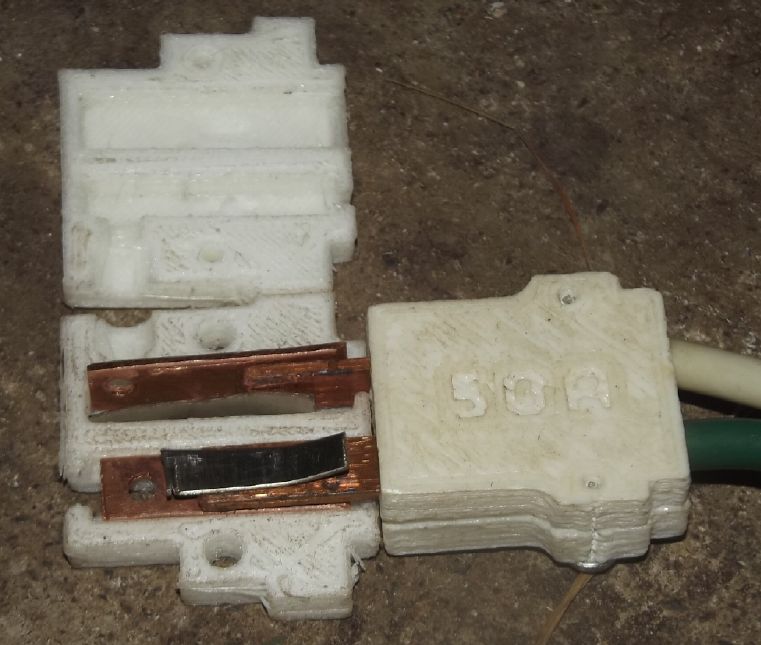 I printed a couple more
sockets - successfully - after the old one fell apart.
I printed a couple more
sockets - successfully - after the old one fell apart.
Getting the springs and blades just right so everything
goes together nicely and the plug isn't loose is a bit of an
art.
Worth noting?: This plug's protruding blades are a little
shorter than the 20mm spec, especially the "+" one.
(The "-" was 19mm.)

On the second socket I made the blade spaces a little longer so
the
plug pins wouldn't hit any excessive solder blobs on the wires.
That was probably overkill but I'm not changing it for now.
Next I want to upload all the 3D printed 36V DC components to
Thingiverse.com .
I don't want to upload anything I haven't tried printing.
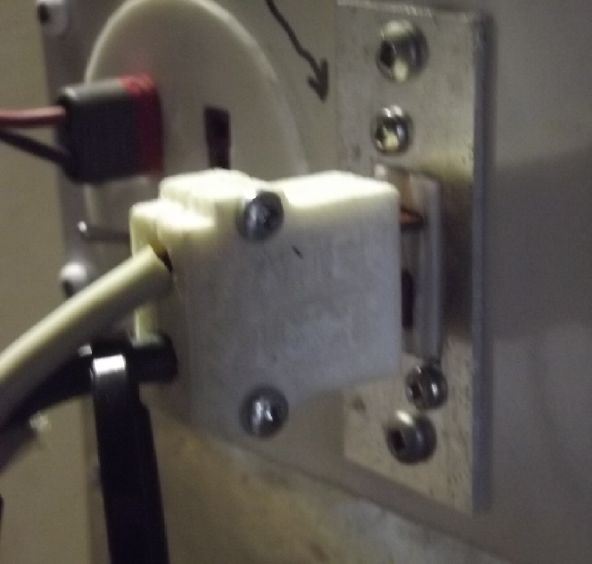 It worked, but the plug wouldn't go
into the new socket all the way
It worked, but the plug wouldn't go
into the new socket all the way
until I filed the plug's blades just a bit (I did that just to
clean the copper).
Now it goes in very snugly with a bit less heat.
(At a constant 41 amps, the #8 AWG cable gets warm along
its whole length, but was a bit warmer at the plug end.)
[July 2nd] I drove to town again. On return the car said 54%
left. I charged for about four hours until the solar box said
6000 WH had been used. The car had gone up to 81%. Interestingly
in the last hour it only went from 79 to 81%, but it was
consuming full power the whole time. At one point, for a few
brief minutes the sun came out and was supplying the whole
amount, over 1600 watts. It didn't last, and as the afternoon
went on it was down to 200 watts with the other 1360 coming from
the house battery. There was 4 hours to go to full charge, which
just might drain the house battery completely, so I quit and
plugged the car into the regular 3.8 KW charger.
With the load off, the house battery rose to about
39.5 volts, which indicated 60-70% charged. Lots left!
In the evening I 3D printed another 50 amp
T-socket. (This is the wall plate / electrical box type
rather than one for an in0line cord.) Now I have the wall plate
and socket for the cabin 50 A receptacle. Getting the blades and
springs right so the plug will go in - and not fall out - is a
matter of delicate adjustments. I start to wonder if the springs
couldn't be printed as part of the nylon socket itself. That
would save considerable fabrication effort and one wouldn't have
to find bits of spring steel.
[July 4th] I drove to Port Clements, all but 90 Km round trip,
and returned with the car at 32% left. I started charging off
the solar again. It was cloudy but a little brighter: ~800W was
coming in from the sun. I charged to 7000 WH, headed for 5 hours
and a dollar's worth of electricity, before I switched it off.
By then the sinking sun was only giving 200 of the 1560 watts.
The house battery said 39.12 volts, indicating around 50% charge
remaining, 5000 watt-hours. That indicated that the sun had
directly supplied 2000 watt-hours of the total. The car was up
to 69%. The AC meter the car charger was plugged through said
only 5830 WH had actually gone to the car, indicating only 83%
inverter efficiency. It was "back to the grid" for the rest of
the charge. That seems poor. Some of it is likely to be an error
difference between two cheap meters.
[July 5th] After driving to town I only charged 2 KWH from the
solar, as the house battery still hadn't fully recharged from
yesterday.
[July 6th] I drove to the Tlell farmers' market again, 35Km
round trip, and charged the car entirely from the house DC/solar
system - several hours. (That's shorter than most of my trips of
over 50Km.) I had returned with the car saying "71%" remaining,
but soon after starting the charge I checked again and it said
"69%"! Also it usually overestimates the time needed to charge.
Not so confidence inspiring that the car really knows exactly
where it's at.
It charged about 7.3 KWH (the most yet from the DC
system) and shut off, saying "100%". For much of the earlier
afternoon the solar was bringing in 800 watts, even 1000, 1100
or 1400 a few times when the sun made some bit of rare
appearance, so the whole charge didn't come direct from the
house battery. By evening that ended up at 39.4V - around
65% charge, the solar system having added 6.36 KWH over the day
including some before and after the car charging. (...almost as
much as the car took.)
[July 8th] After driving to town, for once the rest of the day
was sunny. I charged the leaf from 62% to 100%, drawing around 9
KWH from the house solar over 6 hours. The solar panels pretty
much kept up with the load until the last 3(?) hours as the sun
got low. The rest came from the house battery, which ended the
day around 60% charged. This seemed like a victory of sorts - a
complete recharge of the Leaf after driving 56 Km to town and
back. It was enabled by the sunshine, so far very rare this
summer.
===
Well, that's about enough reporting of each car
charge on the DC system. It's gone from "couldn't get it to
work" and "need to make proper 50 amp T-sockets" to perhaps the
beginnings of "routine".
But a "low voltage cutout" device to end charging
would be the next thing to have. Setting a timer to check on it
so I don't overdischarge the house is all very fine until I
forget to set it or I'm just not in the house to hear it. It
doesn't need constant attention, but having it (or electric
heat) run hour after hour while the house battery goes dead
wouldn't be good.
===
If there ever is an 'apocalypse' where the
electricity is out for a long time, when I get a 50 amp T-socket
in at the cabin too, I would be able to charge for a while at the
house, drive the car down to the cabin, and charge some more at
the cabin. hopefully to full. Should work in summer anyway, even
on most cloudy days. (If it's ever sunny again, in daytime I
wouldn't have to move the car!) I'll print another 50 amp socket
or two while the i3 mega is set up with the nylon filament and the
good file.
Note to self: Also it would be nice to order a second
2500+ watt inverter rather than drag the one unit between
buildings. [30th] I did so while the car was charging.
Faraday Cabin
[up to 10th] I took the hot wire saw and fitted insulation into
the west gable end wall. Then I cut some short boards and some
ugly 1/4 inch plywood and covered it. Later I painted it all - the
wall above the scaffolding - white.
I thought the cracks between the sheets of white
painted plywood walls were ugly. At some point I mixed some
drywall compound and started filling them in as if the sheets were
drywall. Why not? Perhaps some day the wood will swell or
something and the cracks will open up, and maybe the compound will
fall out. But I really expect it'll be fine. especially once
painted. So why work with heavy sheets of gyproc? (Improved fire
safety is one reason, and I'm using gyproc on the walls in the
garage and in the vicinity of the woodstove and the potential
kitchen or utility area.)
Okay, there are a couple of extra challenges. One is
that the plywood doesn't lie flat a nicely as drywall. You need
more screws at the joints, at odd intervals wherever the sheets
happen to bulge out. The second is that you can't sink the screws
in flush or recessed to really hide them.
 On the 29th I finally got a plan
figured out and put up scaffolding so I could insulate and cover
the next section of ceiling. I used genuine 10 foot long steel
scaffold "planks", but not the pipe frames that usually hold them
up. Those were too short to get me up to the ceiling. Instead I
screwed 2 by 4's, into the wall and the stairway and hooked the
ends into those instead.
On the 29th I finally got a plan
figured out and put up scaffolding so I could insulate and cover
the next section of ceiling. I used genuine 10 foot long steel
scaffold "planks", but not the pipe frames that usually hold them
up. Those were too short to get me up to the ceiling. Instead I
screwed 2 by 4's, into the wall and the stairway and hooked the
ends into those instead.
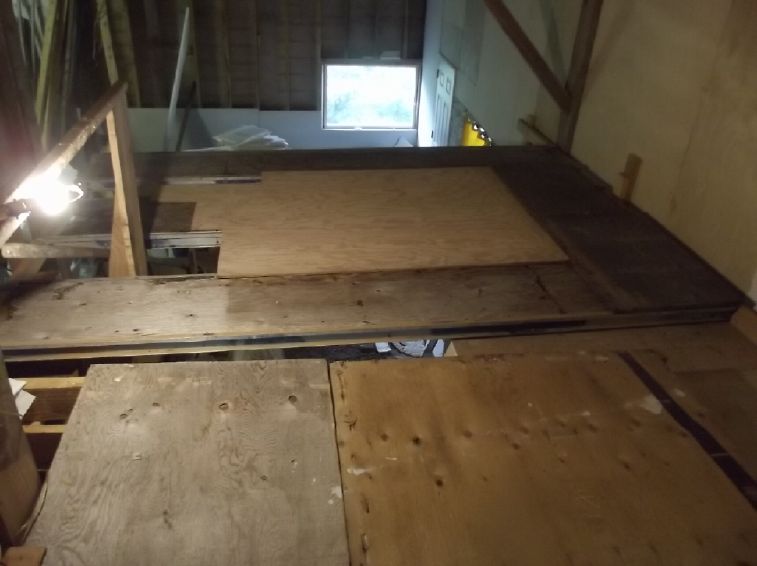 I put some plywood on top to bridge
the gap between pieces and to it get 8 feet wide. There's just
enough width left for me a squeeze by up the stairs. (I'll have to
cover that gap for safety when I get to the top ceiling piece.)
Along with that already up, now scaffolding covers 1/4 of the
entire area of the structure. It will be really nice to have the
west half of the cabin sort of roughly finished. (counting the
upstairs room but minus the garage)
I put some plywood on top to bridge
the gap between pieces and to it get 8 feet wide. There's just
enough width left for me a squeeze by up the stairs. (I'll have to
cover that gap for safety when I get to the top ceiling piece.)
Along with that already up, now scaffolding covers 1/4 of the
entire area of the structure. It will be really nice to have the
west half of the cabin sort of roughly finished. (counting the
upstairs room but minus the garage)
The Electrosmog, Tinnitus, blah blah...
[16th] I've started to get reluctant to sit at any computer.
I turned on the Acer and put in the solar readings of previous
several days from scraps of paper, I selected "Shut Down",
unplugged the power adapter, and went to bed. I woke up bout 2 and
my tinnitus was bad. I had been practicing my supercorder and
attributed it to the music, although I had been wearing ear
protection. But I woke up again at 5 AM and my ears were howling.
It had to be the computer, just six feet away. Let's
see... powered off...(?) DC to DC power adapter unplugged. About
the only explanation was that the WiFi had turned itself back on
when I powered it up or some time during use, and had stayed
on when it was "powered off". I put the computer outside the
cabin door (under a bucket in case of rain). (Now - from tinnitus
effects - I suspect the WiFi is On, even if the computer is Off,
unless "Networking", not just "WiFi", is turned off entirely. This
also appears to be the case with the new laptop, except I'm not
sure you can turn it Off at all.)
I seemed to get a little relief by 8 AM. (Am I
imagining things?) The new laptop discharges its battery in a week
or so when it's "turned off". Something is still running
and drawing substantial power in there... and putting out
electrosmog?
---
It occurs to me that I'm not sure whether the DC to
DC converters are emitting electrical field noise at 50 or 100
KHz, or if it's actual audio - supersonic "humming" of the
components being switched at high frequency. Either way, it seems
to be really aggravating to my tinnitus.
---
Horror of horrors, the ten grid tie inverters for the
new solar system each have a WiFi unit in them! They don't have
any connections to monitor them - it's all done via UHF/WiFi. The
only saving grace it that they'll be just over a grounded metal
roof. I hope it's enough shielding. Because of all the electrical
fields - "electrosmog" - I already hate spending time in the
house, tho I have to for various things.
Fruit & Nut Trees
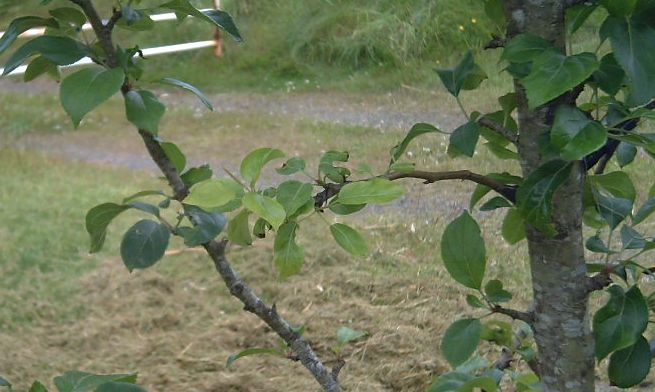 I tried doing six grafts on my apple
and pear trees in March. A leaf came out on one of the pear tree
grafts, then it withered. None of the other grafts seemed to be
doing anything. This matched all my previous grafting experiences
- I had never made a successful graft. Then one of the ones on an
apple tree started budding and leaves came out. Somehow I had left
far more than the 3 or 4 buds one is supposed to leave, but this
one has broken my 100% losing streak. The leaves came out later
and are smaller and more pale than the rest, but it's growing!
I tried doing six grafts on my apple
and pear trees in March. A leaf came out on one of the pear tree
grafts, then it withered. None of the other grafts seemed to be
doing anything. This matched all my previous grafting experiences
- I had never made a successful graft. Then one of the ones on an
apple tree started budding and leaves came out. Somehow I had left
far more than the 3 or 4 buds one is supposed to leave, but this
one has broken my 100% losing streak. The leaves came out later
and are smaller and more pale than the rest, but it's growing!
So I cut away a couple of other small branches to
give it the most space.
 As for fruit, the "pollinator" anjou
pear tree had no flowers. The "pollinator" northern spy apple tree
had no flowers. Notwithstanding that I cut a few buds from someone
else's trees it looked like there were no apples. But for only the
second time, one of the pear trees set fruit. Just three little
pears, all in one clump. (And the first time, a squirrel nipped
off the five tiny pear stems, so I've never had a pear off two,
now three, pear trees in eight years.) Something has already taken
a couple of bites, scarring the skins. (There actually are a very
few apples around the back of the Liberty tree.)
As for fruit, the "pollinator" anjou
pear tree had no flowers. The "pollinator" northern spy apple tree
had no flowers. Notwithstanding that I cut a few buds from someone
else's trees it looked like there were no apples. But for only the
second time, one of the pear trees set fruit. Just three little
pears, all in one clump. (And the first time, a squirrel nipped
off the five tiny pear stems, so I've never had a pear off two,
now three, pear trees in eight years.) Something has already taken
a couple of bites, scarring the skins. (There actually are a very
few apples around the back of the Liberty tree.)
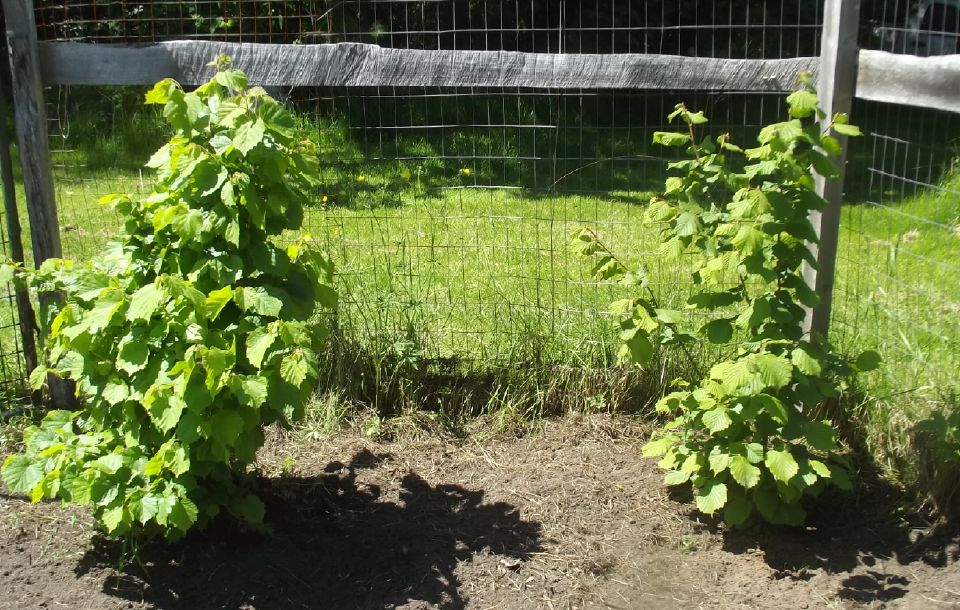 I planted the new Yamhill hazelnut
tree near the Beaked hazelnut in the main garden. Since the Beaked
has now had two years to grow in place, it's much the larger. That
should reverse in the coming years.
I planted the new Yamhill hazelnut
tree near the Beaked hazelnut in the main garden. Since the Beaked
has now had two years to grow in place, it's much the larger. That
should reverse in the coming years.
My walnut trees, nurtured with such expense and care,
which looked great into last autumn, had no leaves, even into
July. One tiny cluster had come out on the Carpathian English
walnut in May, then withered. Although I kept them watered all
winter, I fear this cold, always damp spring has done them in.
Other walnuts in more sheltered locations are doing fine with good
leaves out. The weather finally got nice in the day but nights are
still cold - typical of the BC coast. Then it got cold again. Not
much of a summer! I'm "keeping my fingers crossed", but my hope is
fading each day seeing no growth.
[July 7th] Some tiny buds have appeared in the large walnut! just
sort of erupting from anywhere out of the bark, mostly near the
trunk and not near the ends of the branches. I talked to my
brother and he reminded me of a walnut tree our family had at
Fanny Bay, BC. He said it used to look dead and they thought they
would have to cut it down. Then it would leaf out, long after
everything else had done so. (I never noticed?!?) I guess that's
what's happening here too. Now if only the little black walnut
will also come to life!
Seeing they weren't entirely dead, I put plastic bags
over them to hopefully keep the wind off and help them out
 My largest coffee tree and one of the
other two have been in the kitchen in the porch door window with
an LED grow light too on the inside, since autumn. The greenhouse,
finally reclaimed from the grass this spring, is too full for them
and it's too cold outside.
My largest coffee tree and one of the
other two have been in the kitchen in the porch door window with
an LED grow light too on the inside, since autumn. The greenhouse,
finally reclaimed from the grass this spring, is too full for them
and it's too cold outside.
The largest tree is almost up to the kitchen ceiling.
I put it into a bigger pot. I plucked the last few coffee fruits
and it started flowers for another batch.
The coffee tree now in the greenhouse looks to be
more fruitful this year.
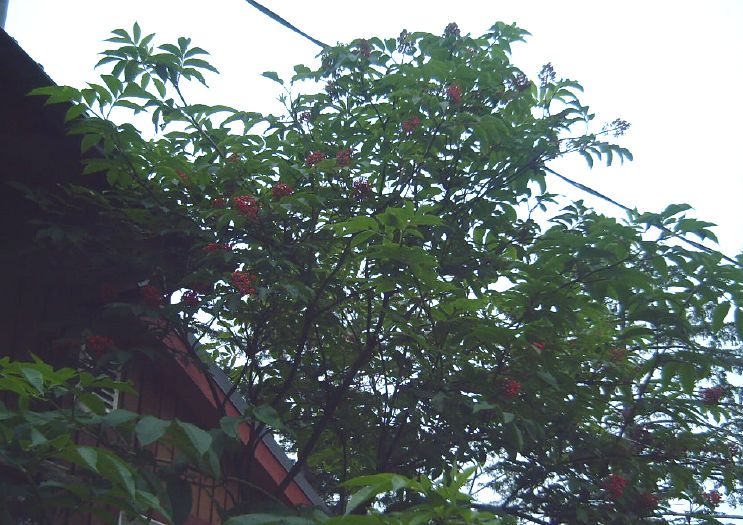 An elderberry bush that started
itself under the porch steps some years ago now has to be cut back
every year to keep it out of the house 240V AC power lines.
Especially this year I cut off two or three main stems because the
electrician will have to get in there for the solar installation
wiring. However, the stem I left is the one that had most of the
berries. The birds are coming around, and I've fed some to the
chickens.
An elderberry bush that started
itself under the porch steps some years ago now has to be cut back
every year to keep it out of the house 240V AC power lines.
Especially this year I cut off two or three main stems because the
electrician will have to get in there for the solar installation
wiring. However, the stem I left is the one that had most of the
berries. The birds are coming around, and I've fed some to the
chickens.
After weeding my blueberries and transplanting the
rest from the main garden where they were unproductive in the
relentless grass, only one of the bushes has a few berries. (I
counted nine.) The rest... I've done my best now, hopefully next
year.
 In the greenhouse the
cherry tree had nothing much, the scout apricot had nothing and
the grape vine had nothing (no flowers this spring - just leaves).
But the other apricot, new last year, was so loaded I had to twist
off about 70 of them, still leaving enough that the branches are
bending down, even to the ground. [Pic. July 1st]
In the greenhouse the
cherry tree had nothing much, the scout apricot had nothing and
the grape vine had nothing (no flowers this spring - just leaves).
But the other apricot, new last year, was so loaded I had to twist
off about 70 of them, still leaving enough that the branches are
bending down, even to the ground. [Pic. July 1st]
After losing my last strawberry tree, I finally
managed to get another small one. This time I planted it in the
greenhouse. Obviously no fruit yet, but it immediately started
growing well.
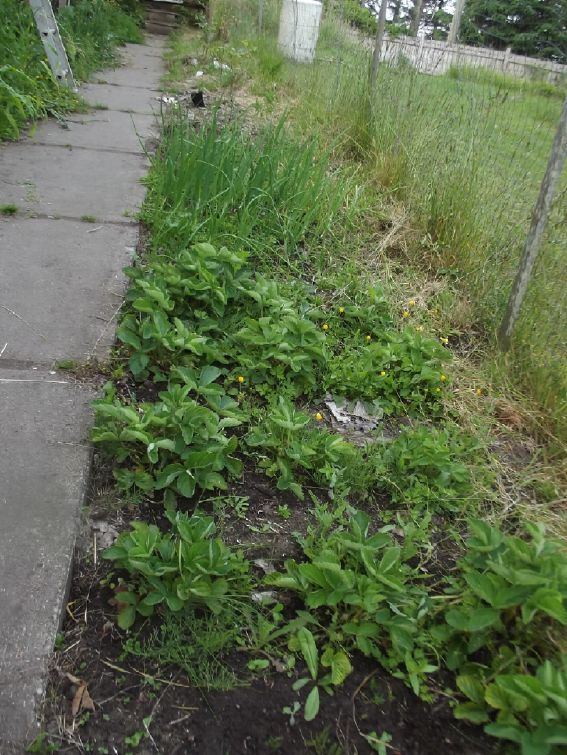 Speaking of
strawberries, those I moved (last fall?) seem to be growing well
after being savaged by the chickens scratching in the winter. A
few berries have ripened as of mid July.
Speaking of
strawberries, those I moved (last fall?) seem to be growing well
after being savaged by the chickens scratching in the winter. A
few berries have ripened as of mid July.
My onions are behind them. The closest one that seem
a bit smaller were grown from seed; the larger ones were "onion
sets" - small bulbs in a package. Those give bigger onions, but
I've grown decent smaller ones from seed too.
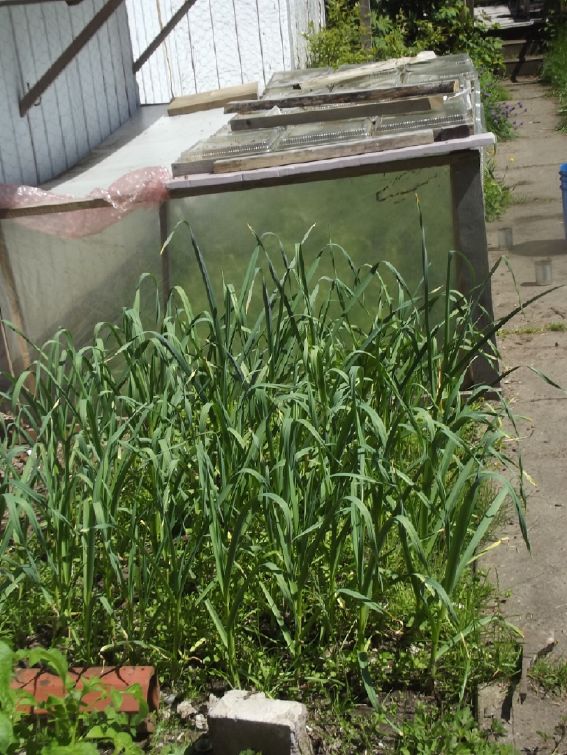 [6th] Across
the sidewalk from the strawberries I had planted a patch of garlic
in October. Of course it starts groing pretty early in the spring.
(If you plant it too soon it sprouts in the fall and is subject to
winter cold.)
[6th] Across
the sidewalk from the strawberries I had planted a patch of garlic
in October. Of course it starts groing pretty early in the spring.
(If you plant it too soon it sprouts in the fall and is subject to
winter cold.)
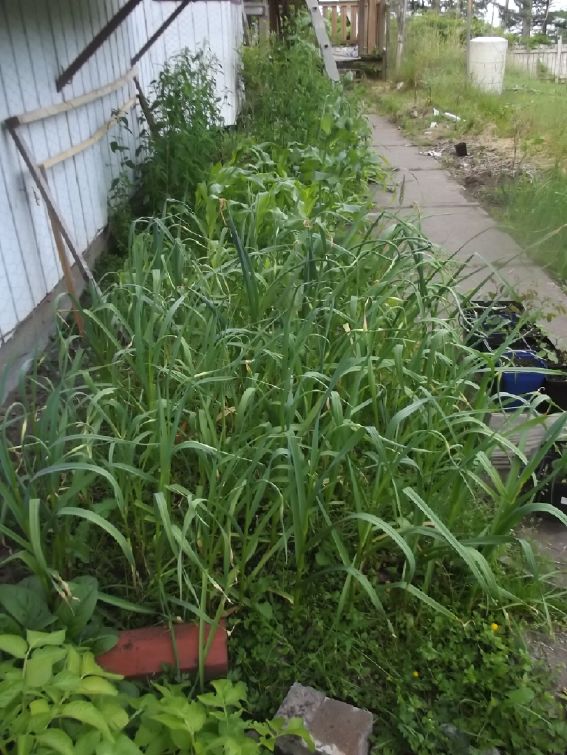 [July 1st] Still growing
[July 1st] Still growing
Greenhouse
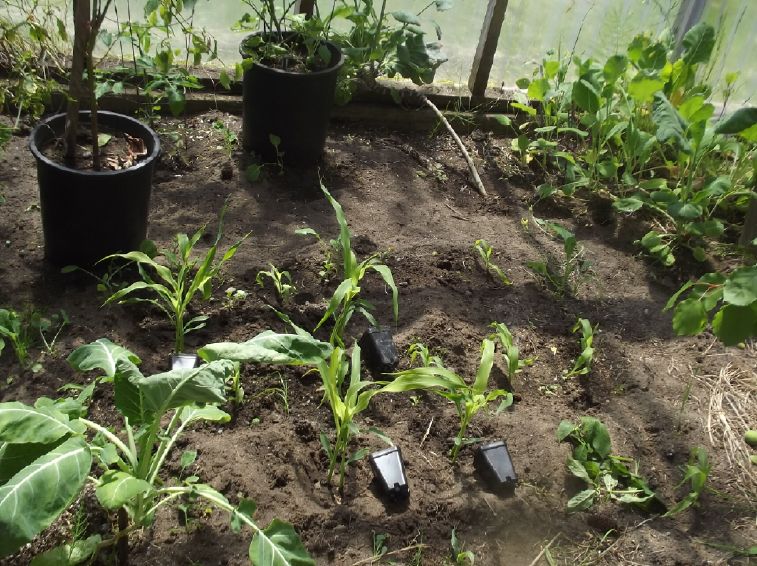 [6th] Dragonfly Garden gave me four
little pots each with two corn plants together when I bought a
nice looking Jalapino pepper plant. Fearing they would reach the
lid and cause me to have to remove the corn box early, I planted
them all in the greenhouse with the "leftover" corn i had
planted there. The tops had a very good head start, but they had
been in tiny pots restricting the roots. Which would grow
better?
[6th] Dragonfly Garden gave me four
little pots each with two corn plants together when I bought a
nice looking Jalapino pepper plant. Fearing they would reach the
lid and cause me to have to remove the corn box early, I planted
them all in the greenhouse with the "leftover" corn i had
planted there. The tops had a very good head start, but they had
been in tiny pots restricting the roots. Which would grow
better?
 [July 1st] The four double corn plants from
Dragonfly Garden were growing nicely in the greenhouse, while
the ones I had transplanted in earlier looked pretty sad. If I
get any corn from the greenhouse, it'll be from these four. I
think I'll try their technique next year - separate little pots
each with two corns and keep the corn inside (under LED lights)
until later before putting it out.
[July 1st] The four double corn plants from
Dragonfly Garden were growing nicely in the greenhouse, while
the ones I had transplanted in earlier looked pretty sad. If I
get any corn from the greenhouse, it'll be from these four. I
think I'll try their technique next year - separate little pots
each with two corns and keep the corn inside (under LED lights)
until later before putting it out.
I should also ask them what variety of corn it is.
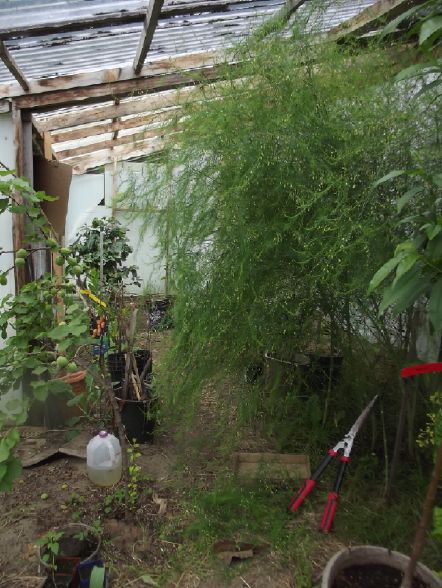 Trimming the asparagus "hedge" so I can
get past it.
Trimming the asparagus "hedge" so I can
get past it.
I always leave one stalk to grow from each root clump.
It must like it here because it has been growing well here maybe
5 years.

West Side, Front Row
with squashes, tomatos, the strawberry tree and (rear) a coffee
tree.
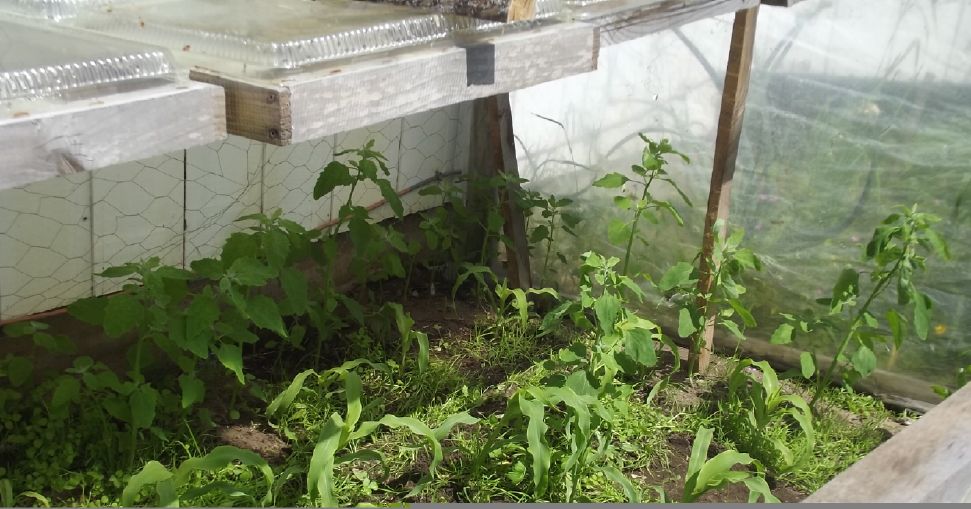 [6th] Corn-in-a-box.
It was planted in a tray in Late March or April and transplanted
into the box in late April.
[6th] Corn-in-a-box.
It was planted in a tray in Late March or April and transplanted
into the box in late April.
Some "volunteer" quinoa sprung up all around the right hand
area. I left some of it around the back and right edge when I
weeded. (Cover pieces are pushed back for foto)
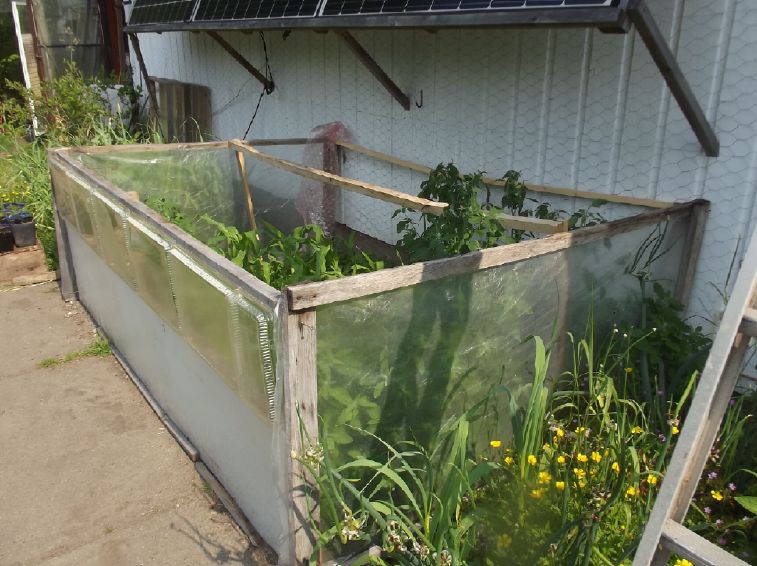 [21st] With the summer equinox came warmer
weather... just for a day or two. That induced me to remove the
box, prematurely. The corn could have gone another week or so, but
all that quinoa was scrunching up against the lid. I noticed some
more quinoa plants crowded together just outside the box, under
the house eaves behind the Egyptian onions. (I guess I could have
put half the "Dragonfly Garden" corn in the box after all - it
wouldn't have hit the lid before the quinoa.)
[21st] With the summer equinox came warmer
weather... just for a day or two. That induced me to remove the
box, prematurely. The corn could have gone another week or so, but
all that quinoa was scrunching up against the lid. I noticed some
more quinoa plants crowded together just outside the box, under
the house eaves behind the Egyptian onions. (I guess I could have
put half the "Dragonfly Garden" corn in the box after all - it
wouldn't have hit the lid before the quinoa.)

Same day, after removing the box.
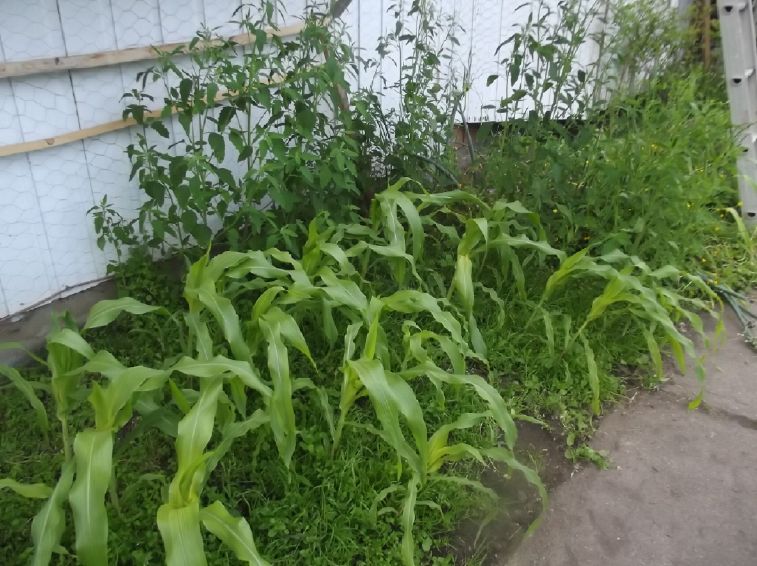 [July 1st] The weather stayed so cold
I started to wish I had just ignored the quinoa and left the box
in place, because the corn growth slowed right down.
[July 1st] The weather stayed so cold
I started to wish I had just ignored the quinoa and left the box
in place, because the corn growth slowed right down.
I kept plucking out big wads of chickweed from
between the corn plants and feeding it to the chickens, but it
didn't seem to slow it down much.
In the main garden, the black currants and josta
berries are doing well. I've had a few raspberries and I expect
the usual big crop, but most of them aren't even close to ripe
yet.
Main Garden
Try as I might, I can't keep the weeds and grass
shorter than the vegetables I plant. They grow like weeds! There
are a few things coming, notably peas and potatos, but this winter
I'm definitely going to try to cover the whole thing with
cardboard. That's not counting the northeast quarter, which is
full of raspberries.
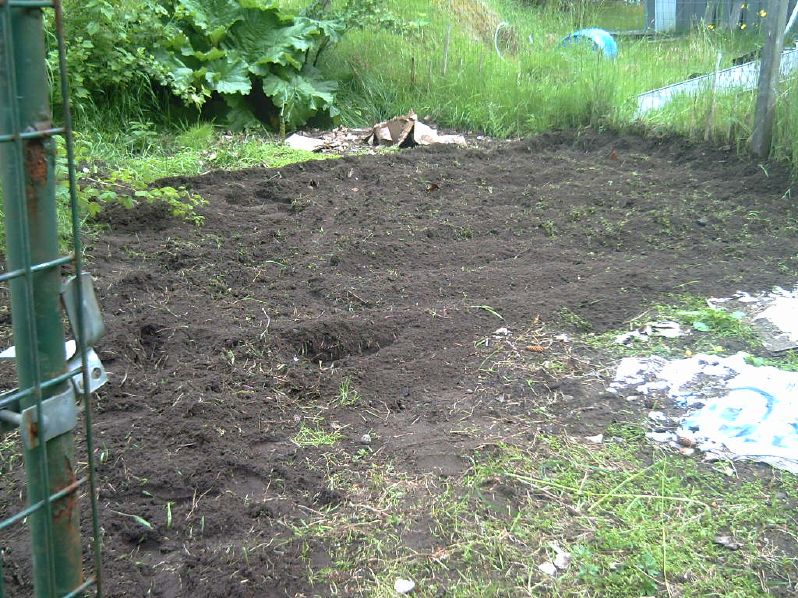 One tactic that was partly successful
was to rototill three times,
One tactic that was partly successful
was to rototill three times,
each a month apart, to keep uprooting the grass and weeds.
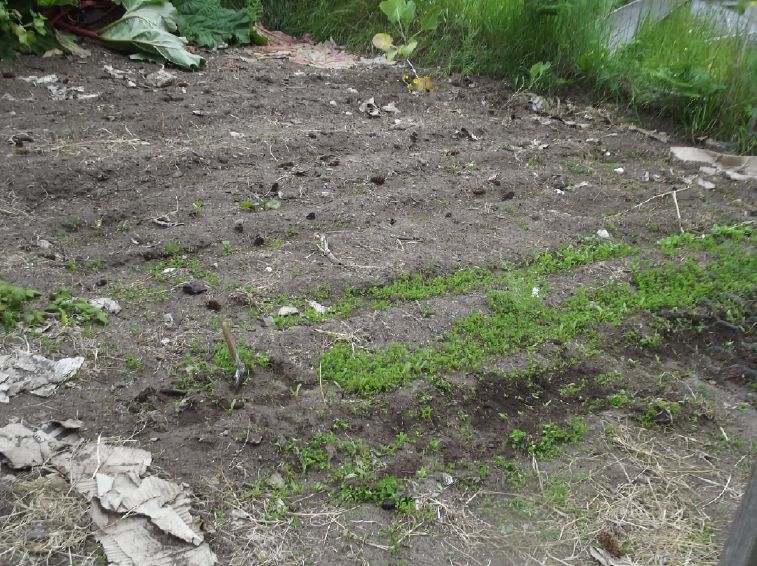 I then planted beets, but the chickweed
came up just as fast where I watered the rows. (front, weeds
scraped away)
I then planted beets, but the chickweed
came up just as fast where I watered the rows. (front, weeds
scraped away)
A week later I planted beans, and the chickweed seemed to have
got dried out and didn't come up as fast. (mid, weedy)
Another week or so after that I planted carrots. By then the
weeds had dried out and way fewer came up (rear left)

[by July 1st...] The beans and carrots were pretty spotty
despite adding more.
I have two rows of peas with the usual 1 inch chicken wire to
climb on. (still
cluttered with dried pea stalks from last year)

After rototilling the southwest quarter the pototos I had
"thoroughly" harvested last year started coming up.
II just added a few more where it looked bare. [July 1st]
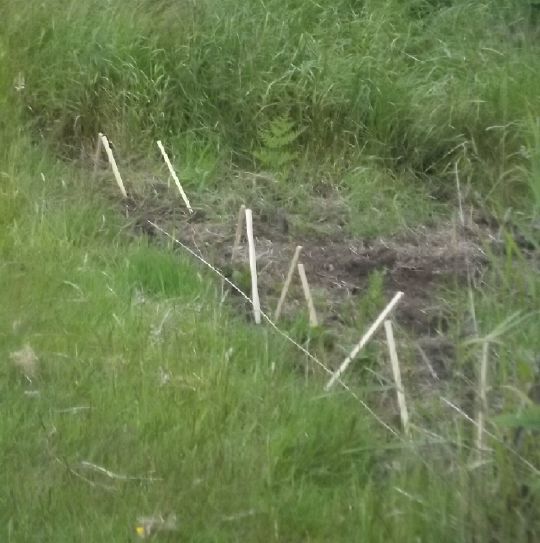
I tilled a patch in the original garden and put in sprouting
potatos.
The deer keep eating my potato tops here. This time I put in
some
stakes to deter them. They didn't seem to help much.
Trees from Seeds
 I moistened birch tree and black
locust tree seeds in a bit of peat in a tray, covered with a
plastic bag, and left them in the fridge for six weeks in
March-April-May to get them to think winter had come and gone,
then I put them in the window. some seeds came up.
I moistened birch tree and black
locust tree seeds in a bit of peat in a tray, covered with a
plastic bag, and left them in the fridge for six weeks in
March-April-May to get them to think winter had come and gone,
then I put them in the window. some seeds came up.
 I ended up with mostly
locust. Their larger seed sprouted first and some birch died soon
after sprouting. I moved them to separate pots after they sprouted
and by early July I had 2 birch and 10 locust growing fast. Now
I'm not so sure where I'll plant any of them. I'll certainly have
to guard them from the deer.
I ended up with mostly
locust. Their larger seed sprouted first and some birch died soon
after sprouting. I moved them to separate pots after they sprouted
and by early July I had 2 birch and 10 locust growing fast. Now
I'm not so sure where I'll plant any of them. I'll certainly have
to guard them from the deer.

 Two years ago my scotch broom was full
of bumblebees. Last year it was honeybees.
Two years ago my scotch broom was full
of bumblebees. Last year it was honeybees.
This year they had no bees at all. Bees have been few and far
between this chilly year
so far, but there were a few on my cloves one day. Next year I
may try putting my beehive
on a roof - up high is where beekeepers place their swarm traps.
New Grid-Tied
Solar Power System
>
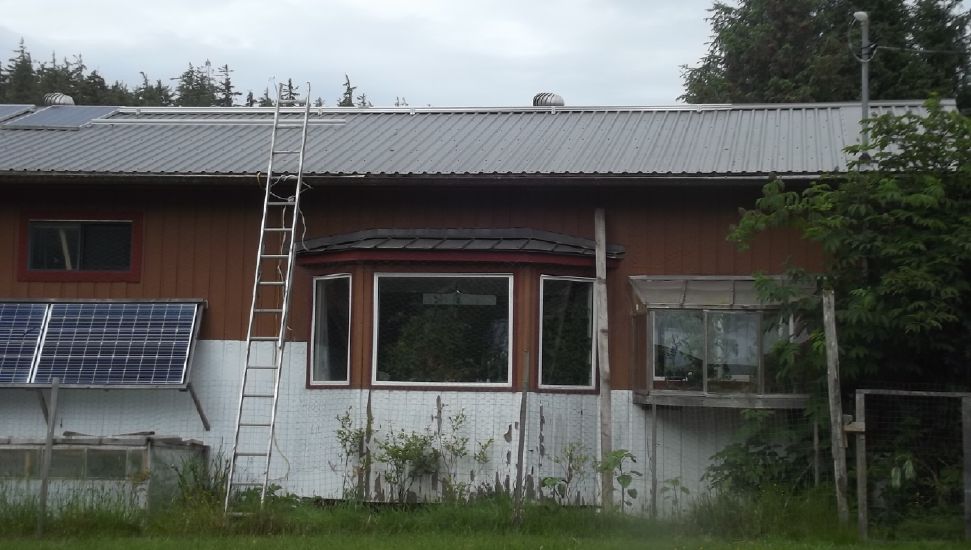
[16th] Putting an ad in HaidaGwaiiTrader.com found a helper
overnight, Dasin, an ex Telus employee who lives just a few km
down the highway. We started installing my new 7 KW (20 - 350 W
solar panels) solar power "kit". We felt our way around and got
the first few of the rails from "Kinetic", which the solar panels
attach to, mounted onto the roof. We measured carefully and
managed to mostly get the long, threaded anchors to screw through
the roof and into rafters, but occasionally we missed. I went into
the attic to see where the drill had come through. We corrected
our aim and I filled in a few holes that missed with roof tar
caulking.
[18th] We got up the rest of the rails. It seems a licensed
electrical contractor is a must (and anyway a good idea to get the
expertise and familiarity with such jobs, and who will have all
the various bits and pieces in stock,), but I had let this slip
until now. Dasin recommended Adam,who works for "Pete the
Electrician", as the electrical contractor. (He said Pete just
does the admin & paperwork these days.) Adam lives in Tlell
but works in Daajing Giids, so he drives by my place to and from
work. He had also lived off grid for a while and done solar
installations, so he was very familiar with the requirements. He
stopped by that very afternoon. He had immediate suggestions about
our work and in e-mails mentioned things needed which might bog us
down with getting approvals if not dealt with ASAP.
[19th] We took up a 12 foot straightedge and made the rails all
even in height (per Adam's suggestion) as the panels may not line
up well otherwise. We put up a couple of panels and a couple of
grid tie inverters. Later I realized we hadn't caulked around the
anchor bolts, so it's well we didn't get much farther. I did that
a day or two later.
 First Panels Up [23rd]
First Panels Up [23rd]
[26th] The wet-ther hasn't cooperated. No real rain, just enough
daily drizzle to keep the metal roof damp (but not the garden). We
managed to work 3 hours and get up a couple more panels and a
couple more inverters. Started cable-tying down the panel wiring.
Then increasing drizzle made roof slippery.
[27th] Still waiting for a dry day.
[July 1st] Sometime I realized that with the microinverters on the
top rails, the ends of the wires - both rows - would be too short
to pull out below the solar panels for connection into the house.
We pulled off two panels and all four inverters and moved the
inverters to the bottom rail of each row to gain the vital three
feet or so.
We got the same inverters and eight solar panels up
just before the end of our usual four hour workday, when it
started to rain as we bolted down the eighth panel. Even a little
rain makes the roof slippery and dangerous. Otherwise we might
have got up two more panels and reached the half way point. Six
inverters and twelve panels to go. (Hmm... What has happened to my
electrician?)
[July 2nd] We decided to chance the weather and put up some more
solar panels and inverters. We worked about 3 hours and then
suddenly, a heavy rain while we were carrying up another panel. We
grabbed the tools and quit.

[July 3rd] For the first time in much too long: A Warm, Sunny Day!
In two hours we had the remaining inverters and panels up. It
turned out the electrician had been at his sister's. She was
having a baby and he was looking after her kids. He finally
emailed me with the company's name and details for "Pete the
Electrician".
With that info I could finally fill in the BC Hydro
rebate application on the web. On this it said 50% of costs with
maximum rebate 5000$. Wait... what happened to "up to 75% of
cost?" "Wherever in BC power was from a microgrid with diesel
generators." And I had thought it was 15 or 20,000 $ max. rebate.
That's what I remember BC Hydro saying at the Swiilawiid Renewable
Energy Conference in September, and that was the basis on which I
decided to take on the project. This has cost me 16,000$ - so far!
(with Electrical contractor's work and inspection/approvals costs
still to go.) Reading over the actual terms, 75% with a higher top
figure is only if it's under auspices of a native band council.
What I was TOLD at the conference was that OR for anyone if your
power comes from a microgrid running off of diesel.. I'm not sure
I would have / should have started this. I inherited some money,
but I hadn't planned on spending most of it in this one place. It
was 4500$ just for the shipping of the solar "kit".
Solar Panel Efficiencies
My old (2017?) solar panels were rated 305 watts. The
new (2024?) ones are 350. 2011 panels used to be around only 250
watts and I keep hearing about ever increasing solar panel
efficiencies. But the new panels are bigger. I measured to the
outside edges of the cells on both panels and calculated. The 350
versus the 305 worked out to within 1% of the same rated
collection per unit area. It seems that for almost a decade
efficiency of actual commercial panels hasn't changed.
My (Old) Solar Power System(s)
(My solar panels recent images - TE News #200)
The Usual Daily/Monthly/Yearly
Log of Solar Power Generated [and grid power consumed]
Notes:
* All times are in PST: clock ~48 minutes ahead of local
sun time, never PDT which is an hour and 48 minutes ahead.
* Unapproved AC/Grid Tied systems have been removed.
* House panels include four old ones on the roof (upper - total
rating ~ 1000W), two 305W on the roof, three 305W on the south
wall below the roof, and one broken panel mounted verticly on the
porch railing (seems to still work but a lot of shade there).
* Cabin DC includes the three carport panels and the two on a pole
in the yard as well as the four on the cabin roof itself. All nine
are 305W.
* The wall, pole and porch panels are easily wiped off from the
ground if it snows.
* Km = Nissan Leaf electric car drove distance, then car was
charged. Car KWH does not add to or subtract from any other
readings.
Recent fotos of solar panels, TE News #200:
House System Panels: House roof, wall (9 solar panels) -
Porch (1 broken one - usually shady)
Cabin System Panels: Carport (3 - sunniest place on the
whole property) - Pole (2 - shadiest place) -Faraday Cabin (4 -
badly shaded in winter)
New Order of Daily Solar Readings (Beginning November 2024):
Date HouseDC, CabinDC => Total KWH Solar [Notable power Uses
(EV); Grid power meter@time] Sky/weather, notes...
May
31st 393.60, 311.70 => 12.11 [110Km; 29193@'24:00'] Similar
June
1st 397.60, 316.55 => 8.85 [29222@21:30]
2nd 402.54, 322.79 => 11.18 [29279@'25:00']
3rd -- missed --
=> 9.69
4th 412.72, 336.00 => 13.70 [50Km; 29365@21:30]
(estimates: 23.39/2=11.70 but today was notably sunnier.)
5th 417.93, 341.50 => 10.71 [55Km; 29404@21:30]
6th 423.95, 347.67 => 12.19 [29434@21:00] Wow, a real,
sunny day! (So warm I'm running less heat!)
7th 429.76, 356.63 => 14.77 [115Km; 29483@21:00]
8th 434.85, 362.83 => 11.29 [29506@21:00]
9th missed ... => 12.92 (est)
10th 446.27, 376.35 => 12.92 /(est) [29563@23:30] (25.84 KWH /
2 = 12.92)
11th 452.34, 382.06 => 11.78 [55Km; 29580@21:30]
12th 457.81, 389.71 => 13.12 [29606@21:30]
13rd 463.55, 397.00 => 13.03 [55Km; 29638@'24:30']
14th missed ... => 10.60
15th 472.92, 408.84 => 10.61 [29718@21:00] (21.21 / 2 = 10.605)
16th 478.69, 416.44 => 13.37 [29743@22:30]
17th 483.15, 421.35 => 9.37 [65Km; 29765@21:00]
18th 488.57, 427.53 => 11.60 [29797@23:30]
19th 493.94, 434.06 => 11.40 [29809@21:00]
20th 499.88, 438.89 => 10.77 [85Km; 29860@21:30]
21st 505.30, 442.72 => 9.25 [55Km;
29882@22:00]
22nd 510.36, 447.79 => 10.13 [29906@'24:00']
23rd 512.18, 450.18 => 4.21 [40Km; 29942@'24:30']
24th 516.06, 455.70 => 9.40 [55Km; 29977@21:30]
25th 519.86, 459.87 => 7.97 [55Km; 29996@'24:00']
Charged Leaf with inverter from house DC/solar, 4.000 KWH.
(Regular 230V AC charger for the other ~~4.5KWH)
26th 524.22, 464.01 => 8.50 [30021@23:30]
27th 527.77, 468.21 => 7.75 [85Km; 30055@21:30]
28th 532.43, 473.32 => 9.77 [60Km; 30093@'24:00']
ANOTHER dull, cloudy,cold day
29th 535.63, 477.18 => 7.06 [35Km; 30126@21:30]
30th 539.18, 482.67 => 9.04 [10Km; 30152@21:00]
July
1st 543.58, 487.58 => 9.86
[30179@23:00]
2nd - missed - => (est) 9.50 [55Km; -- ]
3rd 553.52, 497.41 => 10.27 [30229@20:30] Finally, ONE
sunny day!
4th 558.38, 502.60 => 10.05 [90Km; 30248@21:30] ...then
mor clouds & cool to cold.
5th 562.06, 507.06 => 8.14 [75Km; 30282@21:00]
& mor
6th 568.40, 513.34 => 12.62 [35Km; 30301@19:30] &
mor
7th 571.25, 516.85 => 6.36 [30330@23:30]
& mor
8th 580.16, 522.90 => 14.96 [55Km; 30359@21:30] A
largely sunny day(!) after a few AM rains. The batteries got a
chance to recharge plus I charged the leaf, around 9 KWH. The
house solar energy pretty much kept up until the last 3(?) hours
as the sun got low, but ended up only around 60% charged.
9th 589.33, 529.21 => 15.48 [20Km; 20383@23:00] Enuf sun
to make up for chj. car 9KWH (yest) & 5 KWH.
10th 593.23, 533.50 => 8.19 [30411@23:30]
11th 596.91, 538.08 => 8.26 [30424@22:00]
12th 600.72, 542.29 => 8.02 [105Km; 30474@'24:00']
Chart of daily KWH from solar panels. (Compare June 2025 with May 2025 & June
2024.)
Days of
__ KWH
|
June 2025
(18 Collectors,
DC/ Batteries.)
|
May 2025
(18 C's - DC/
batteries only)
|
June 2024
(18 C's - Grid
Ties & DC)
|
0.xx
|
|
|
|
1.xx
|
|
|
|
2.xx
|
|
|
|
3.xx
|
|
|
|
4.xx
|
1 yowr!
|
|
|
5.xx
|
|
|
|
6.xx
|
|
2
|
|
7.xx
|
3
|
1
|
|
8.xx
|
2
|
3
|
2
|
9.xx
|
6
|
7
|
1
|
10.xx
|
5
|
5
|
|
11.xx
|
5
|
3
|
1
|
12.xx
|
3
|
5
|
3
|
13.xx
|
4
|
3
|
5
|
14.xx
|
1
|
2
|
3
|
15.xx
|
|
|
|
16.xx
|
|
|
5
|
17.xx
|
|
|
2
|
18.xx
|
|
|
1
|
19.xx
|
|
|
1
|
20.xx
|
|
|
1
|
21.xx
|
|
|
|
22.xx
|
|
|
2
|
23.xx
|
|
|
2
|
24.xx
|
|
|
|
25.xx
|
|
|
1
|
Total KWH
for month
|
316.55
|
333.32 |
420
|
Km Driven
on Electricity
|
1038.9
@8.2 KWH/Km
= 130 KWH
|
1159.3
@7.9 kwh/Km
= 150 KWH |
~1465 Km
190 KWH
|
Things Noted - June 2025
* An awful lot of miserable weather, following a miserable May.
Monthly Summaries: Solar Generated KWH [& Power
used from grid KWH]
As these tables are getting long, I'm not repeating the log of
monthly reports. The reports for the first FIVE full years (March
2019 to February 2024) may be found in TE News #189, February 2024.
2024
Month: HouseAC + DC +Carport+Cabin[+DC] (from Aug 2024)
Jan KWH: 31.37 + 3.14 + 16.85 + 16.82 = 68.18
[grid power used: 909; car (very rough estimates): 160*]
Feb KWH: 96.52 + 2.36 + 49.67 + 52.98 = 201.53 [grid: 791;
car: 130]
FIVE full Years of solar!
Mar KWH 150.09+ 1.63 + 93.59 + 92.50 = 337.81
[grid: 717; car: 140]
Apr KWH 181.89+35.55 +123.50+142.74 = 483.68
[grid: 575; car: 140]
May KWH 129.23+67.38 +109.6 +126.32 = 432.53
[grid: 405; car: 145]
Jun KWH 152.54+51.02+118.99+141.17 = 463.72
[grid: 420; car: 190]
July KWH 174.22+30.53+111.19+128.62 = 444.56
[grid: 386; car: 165]
Aug KWH 221.99+ 2.63 +142.49+151.67+ 5.78 = 524.56 [grid:
358; car: 180]
SeptKWH 120.98+ 2.49 + 83.50 + 19.10+ 39.95 = 266.02 [grid: 662
(yowr!); car: 155*]
Oct KWH 78.48+ 7.29 + 64.39 + 7.52 + 40.75 =
198.43 [grid: 711; car: 120*]
Nov KWH 19.63+12.19+ 23.90 + 3.35 + 25.62
= 84.69 [grid: 900 (ACK!);car: 110*]
Now solar is charging
batteries only. 2 DC systems: house, cabin.
Dec KWH 20.37 + 16.76 = 37.13 [grid: 1866 (using electric
heat - awg!); car: 120*]
2025
Jan KWH 35.02 + 26.30 = 61.32 [grid: 2136 (electric
heat OW!); car: 120*]
Feb KWH 55.43 + 39.00 = 94.43 [grid: 1937; car: 100*]
SIX full Years of
solar!
Mar KWH 115.13 + 87.41 = 202.54
[grid: 1860; car: 155* KWH]
Apr KWH 126.25 + 120.36 = 246.61 [grid: 1246; car: 100*]
May KWH 147.08 + 186.24 = 333.32 [grid: 1354; car: 150*]
Jun 145.58 + 170.97 = 316.55 [grid: 959; car: 130*]
* Car consumption comes from solar and or
grid: it does not add to other figures. (Just from grid from
Nov. 18th. 2024 on)
Annual Totals
1. March 2019-Feb. 2020: 2196.15 KWH Solar [used 7927
KWH from grid; EV use: -] 10, 11, 12 solar panels
2. March 2020-Feb. 2021: 2069.82 KWH Solar [used 11294 KWH from
grid; EV use: - (More electric heat - BR, Trailer & Perry's
RV)] 12 solar panels
3. March 2021-Feb. 2022: 2063.05 KWH Solar [used 10977 KWH from
grid; EV use ~~1485 KWH] 12 solar panels, 14 near end of year.
4a. March 2022-August 2022: in (the best) 6 months, about 2725 KWH
solar - more than in any previous entire year!
4. March2022-Feb. 2023: 3793.37 KWH Solar [used 12038 KWH from
grid; EV use: ~1583 KWH] 14, 15, 18 solar panels
5. March 2023-Feb. 2024: 3891.35 KWH Solar [used 7914 KWH from
power grid; EV use: ~1515 KWH] 18 solar panels
6. March 2024-Feb. 2025: 3428.88 KWH Solar [used 12773 KWH from
grid; EV used: ~1685 KWH]
Money Saved or Earned - @ 12¢ [All BC residential elec.
rate] ; @ 50¢ [2018 cost of diesel fuel to BC Hydro] ; @ 1$ per
KWH [actual total cost to BC Hydro in 2022 according to an
employee]; or maybe it's 62 ¢/KWH [according to BC Hydro at
Renewable Energy Symposium Sept. 2024]:
1. 263.42$ ; 1097.58$ ; 2196.15$
2. 248.38$ ; 1034.91$ ; 2069.82$
3. 247.57$ ; 1031.53$ ; 2063.05$
4. 455.20$ ; 1896.69$ ; 3793.37$
5. 466.96$ ; 1945.68$ ; 3891.35$
6. 411.47$ ; 1714.44$ ; 3428.88$
I had to disconnect the system from the grid in
November 2024. These two now independent installations (house,
cabin) will continue to run their 36 volt DC systems and I'll see
how I can most effectively utilize the available solar energy with
the limited available storage.
http://www.TurquoiseEnergy.com
Haida Gwaii, BC Canada




 The first hurdle to
making it work was that when plugged into the inverter the Leaf's
charging unit just sat there with its green light blinking. Turns
out it thinks it's plugged into a 2-prong cord and decides that's
not good enough. But inverters have no ground on the ground pin.
Where would they get a ground from? One must use a plug to short
neutral to ground, to trick it. In order to connect that, one must
plug a power bar or splitter into the inverter, to plug in both
the Leaf's charger and the ground-to-neutral shorting plug. (Foto:
I also put an AC power monitor in line with the charger.)
The first hurdle to
making it work was that when plugged into the inverter the Leaf's
charging unit just sat there with its green light blinking. Turns
out it thinks it's plugged into a 2-prong cord and decides that's
not good enough. But inverters have no ground on the ground pin.
Where would they get a ground from? One must use a plug to short
neutral to ground, to trick it. In order to connect that, one must
plug a power bar or splitter into the inverter, to plug in both
the Leaf's charger and the ground-to-neutral shorting plug. (Foto:
I also put an AC power monitor in line with the charger.) Then my long house-wire
to the 36V, 50A outlet in the kitchen wasn't actually heavy enough
for 50 amps. The inverter would cut out almost as soon as the
charge started because the voltage dropped too much.
Then my long house-wire
to the 36V, 50A outlet in the kitchen wasn't actually heavy enough
for 50 amps. The inverter would cut out almost as soon as the
charge started because the voltage dropped too much.




 Near the end of the month I figured
out how to put up scaffolding to do the next section of ceiling,
using actual steel frame scaffolding "planks" but with 2 by 4's
screwed into place to hook the ends onto. I spread them apart to
expand the "floor" area, and put chunks of plywood across to stand
on.
Near the end of the month I figured
out how to put up scaffolding to do the next section of ceiling,
using actual steel frame scaffolding "planks" but with 2 by 4's
screwed into place to hook the ends onto. I spread them apart to
expand the "floor" area, and put chunks of plywood across to stand
on. That 36 volts won't electrocute
doesn't mean it can't arc and get hot with high loads and poor
connections. The middle socket on this plate in my bedroom had a
badly connecting electric heater which finally did in the plate
plastic. The socket itself is high temperature nylon - and this is
why.
That 36 volts won't electrocute
doesn't mean it can't arc and get hot with high loads and poor
connections. The middle socket on this plate in my bedroom had a
badly connecting electric heater which finally did in the plate
plastic. The socket itself is high temperature nylon - and this is
why.




 So I took the DC power
cord off the inverter and put on an Anderson APP connector cable,
and took it out to the garage where the DC system box had that
connector.
So I took the DC power
cord off the inverter and put on an Anderson APP connector cable,
and took it out to the garage where the DC system box had that
connector.



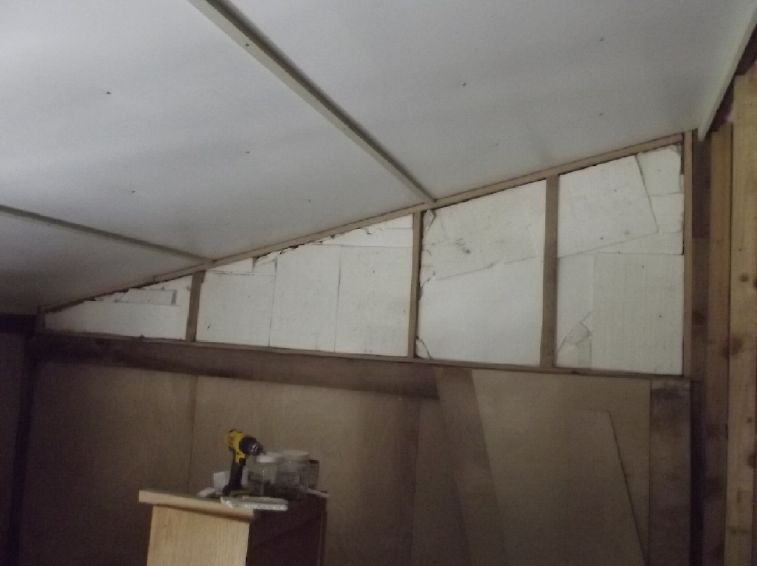
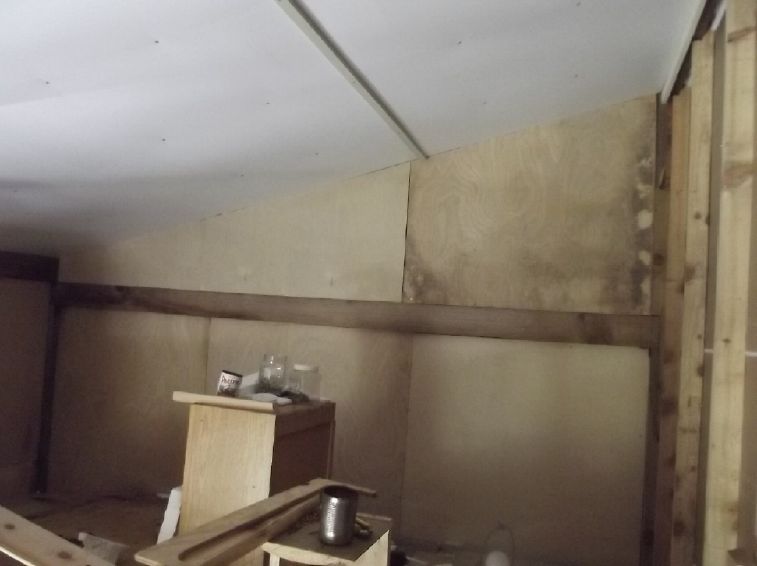

 On the 29th I finally got a plan
figured out and put up scaffolding so I could insulate and cover
the next section of ceiling. I used genuine 10 foot long steel
scaffold "planks", but not the pipe frames that usually hold them
up. Those were too short to get me up to the ceiling. Instead I
screwed 2 by 4's, into the wall and the stairway and hooked the
ends into those instead.
On the 29th I finally got a plan
figured out and put up scaffolding so I could insulate and cover
the next section of ceiling. I used genuine 10 foot long steel
scaffold "planks", but not the pipe frames that usually hold them
up. Those were too short to get me up to the ceiling. Instead I
screwed 2 by 4's, into the wall and the stairway and hooked the
ends into those instead. I put some plywood on top to bridge
the gap between pieces and to it get 8 feet wide. There's just
enough width left for me a squeeze by up the stairs. (I'll have to
cover that gap for safety when I get to the top ceiling piece.)
Along with that already up, now scaffolding covers 1/4 of the
entire area of the structure. It will be really nice to have the
west half of the cabin sort of roughly finished. (counting the
upstairs room but minus the garage)
I put some plywood on top to bridge
the gap between pieces and to it get 8 feet wide. There's just
enough width left for me a squeeze by up the stairs. (I'll have to
cover that gap for safety when I get to the top ceiling piece.)
Along with that already up, now scaffolding covers 1/4 of the
entire area of the structure. It will be really nice to have the
west half of the cabin sort of roughly finished. (counting the
upstairs room but minus the garage) I tried doing six grafts on my apple
and pear trees in March. A leaf came out on one of the pear tree
grafts, then it withered. None of the other grafts seemed to be
doing anything. This matched all my previous grafting experiences
- I had never made a successful graft. Then one of the ones on an
apple tree started budding and leaves came out. Somehow I had left
far more than the 3 or 4 buds one is supposed to leave, but this
one has broken my 100% losing streak. The leaves came out later
and are smaller and more pale than the rest, but it's growing!
I tried doing six grafts on my apple
and pear trees in March. A leaf came out on one of the pear tree
grafts, then it withered. None of the other grafts seemed to be
doing anything. This matched all my previous grafting experiences
- I had never made a successful graft. Then one of the ones on an
apple tree started budding and leaves came out. Somehow I had left
far more than the 3 or 4 buds one is supposed to leave, but this
one has broken my 100% losing streak. The leaves came out later
and are smaller and more pale than the rest, but it's growing! As for fruit, the "pollinator" anjou
pear tree had no flowers. The "pollinator" northern spy apple tree
had no flowers. Notwithstanding that I cut a few buds from someone
else's trees it looked like there were no apples. But for only the
second time, one of the pear trees set fruit. Just three little
pears, all in one clump. (And the first time, a squirrel nipped
off the five tiny pear stems, so I've never had a pear off two,
now three, pear trees in eight years.) Something has already taken
a couple of bites, scarring the skins. (There actually are a very
few apples around the back of the Liberty tree.)
As for fruit, the "pollinator" anjou
pear tree had no flowers. The "pollinator" northern spy apple tree
had no flowers. Notwithstanding that I cut a few buds from someone
else's trees it looked like there were no apples. But for only the
second time, one of the pear trees set fruit. Just three little
pears, all in one clump. (And the first time, a squirrel nipped
off the five tiny pear stems, so I've never had a pear off two,
now three, pear trees in eight years.) Something has already taken
a couple of bites, scarring the skins. (There actually are a very
few apples around the back of the Liberty tree.) I planted the new Yamhill hazelnut
tree near the Beaked hazelnut in the main garden. Since the Beaked
has now had two years to grow in place, it's much the larger. That
should reverse in the coming years.
I planted the new Yamhill hazelnut
tree near the Beaked hazelnut in the main garden. Since the Beaked
has now had two years to grow in place, it's much the larger. That
should reverse in the coming years. My largest coffee tree and one of the
other two have been in the kitchen in the porch door window with
an LED grow light too on the inside, since autumn. The greenhouse,
finally reclaimed from the grass this spring, is too full for them
and it's too cold outside.
My largest coffee tree and one of the
other two have been in the kitchen in the porch door window with
an LED grow light too on the inside, since autumn. The greenhouse,
finally reclaimed from the grass this spring, is too full for them
and it's too cold outside. An elderberry bush that started
itself under the porch steps some years ago now has to be cut back
every year to keep it out of the house 240V AC power lines.
Especially this year I cut off two or three main stems because the
electrician will have to get in there for the solar installation
wiring. However, the stem I left is the one that had most of the
berries. The birds are coming around, and I've fed some to the
chickens.
An elderberry bush that started
itself under the porch steps some years ago now has to be cut back
every year to keep it out of the house 240V AC power lines.
Especially this year I cut off two or three main stems because the
electrician will have to get in there for the solar installation
wiring. However, the stem I left is the one that had most of the
berries. The birds are coming around, and I've fed some to the
chickens. In the greenhouse the
cherry tree had nothing much, the scout apricot had nothing and
the grape vine had nothing (no flowers this spring - just leaves).
But the other apricot, new last year, was so loaded I had to twist
off about 70 of them, still leaving enough that the branches are
bending down, even to the ground. [Pic. July 1st]
In the greenhouse the
cherry tree had nothing much, the scout apricot had nothing and
the grape vine had nothing (no flowers this spring - just leaves).
But the other apricot, new last year, was so loaded I had to twist
off about 70 of them, still leaving enough that the branches are
bending down, even to the ground. [Pic. July 1st] Speaking of
strawberries, those I moved (last fall?) seem to be growing well
after being savaged by the chickens scratching in the winter. A
few berries have ripened as of mid July.
Speaking of
strawberries, those I moved (last fall?) seem to be growing well
after being savaged by the chickens scratching in the winter. A
few berries have ripened as of mid July. [6th] Across
the sidewalk from the strawberries I had planted a patch of garlic
in October. Of course it starts groing pretty early in the spring.
(If you plant it too soon it sprouts in the fall and is subject to
winter cold.)
[6th] Across
the sidewalk from the strawberries I had planted a patch of garlic
in October. Of course it starts groing pretty early in the spring.
(If you plant it too soon it sprouts in the fall and is subject to
winter cold.) [July 1st] Still growing
[July 1st] Still growing [6th] Dragonfly Garden gave me four
little pots each with two corn plants together when I bought a
nice looking Jalapino pepper plant. Fearing they would reach the
lid and cause me to have to remove the corn box early, I planted
them all in the greenhouse with the "leftover" corn i had
planted there. The tops had a very good head start, but they had
been in tiny pots restricting the roots. Which would grow
better?
[6th] Dragonfly Garden gave me four
little pots each with two corn plants together when I bought a
nice looking Jalapino pepper plant. Fearing they would reach the
lid and cause me to have to remove the corn box early, I planted
them all in the greenhouse with the "leftover" corn i had
planted there. The tops had a very good head start, but they had
been in tiny pots restricting the roots. Which would grow
better? [July 1st] The four double corn plants from
Dragonfly Garden were growing nicely in the greenhouse, while
the ones I had transplanted in earlier looked pretty sad. If I
get any corn from the greenhouse, it'll be from these four. I
think I'll try their technique next year - separate little pots
each with two corns and keep the corn inside (under LED lights)
until later before putting it out.
[July 1st] The four double corn plants from
Dragonfly Garden were growing nicely in the greenhouse, while
the ones I had transplanted in earlier looked pretty sad. If I
get any corn from the greenhouse, it'll be from these four. I
think I'll try their technique next year - separate little pots
each with two corns and keep the corn inside (under LED lights)
until later before putting it out.

 [6th] Corn-in-a-box.
It was planted in a tray in Late March or April and transplanted
into the box in late April.
[6th] Corn-in-a-box.
It was planted in a tray in Late March or April and transplanted
into the box in late April. [21st] With the summer equinox came warmer
weather... just for a day or two. That induced me to remove the
box, prematurely. The corn could have gone another week or so, but
all that quinoa was scrunching up against the lid. I noticed some
more quinoa plants crowded together just outside the box, under
the house eaves behind the Egyptian onions. (I guess I could have
put half the "Dragonfly Garden" corn in the box after all - it
wouldn't have hit the lid before the quinoa.)
[21st] With the summer equinox came warmer
weather... just for a day or two. That induced me to remove the
box, prematurely. The corn could have gone another week or so, but
all that quinoa was scrunching up against the lid. I noticed some
more quinoa plants crowded together just outside the box, under
the house eaves behind the Egyptian onions. (I guess I could have
put half the "Dragonfly Garden" corn in the box after all - it
wouldn't have hit the lid before the quinoa.)
 [July 1st] The weather stayed so cold
I started to wish I had just ignored the quinoa and left the box
in place, because the corn growth slowed right down.
[July 1st] The weather stayed so cold
I started to wish I had just ignored the quinoa and left the box
in place, because the corn growth slowed right down.




 I moistened birch tree and black
locust tree seeds in a bit of peat in a tray, covered with a
plastic bag, and left them in the fridge for six weeks in
March-April-May to get them to think winter had come and gone,
then I put them in the window. some seeds came up.
I moistened birch tree and black
locust tree seeds in a bit of peat in a tray, covered with a
plastic bag, and left them in the fridge for six weeks in
March-April-May to get them to think winter had come and gone,
then I put them in the window. some seeds came up. I ended up with mostly
locust. Their larger seed sprouted first and some birch died soon
after sprouting. I moved them to separate pots after they sprouted
and by early July I had 2 birch and 10 locust growing fast. Now
I'm not so sure where I'll plant any of them. I'll certainly have
to guard them from the deer.
I ended up with mostly
locust. Their larger seed sprouted first and some birch died soon
after sprouting. I moved them to separate pots after they sprouted
and by early July I had 2 birch and 10 locust growing fast. Now
I'm not so sure where I'll plant any of them. I'll certainly have
to guard them from the deer.



